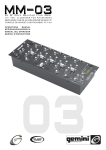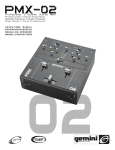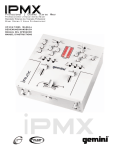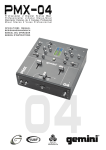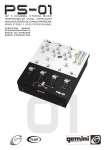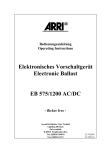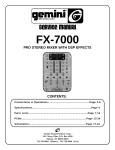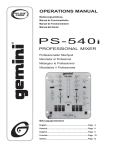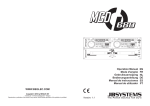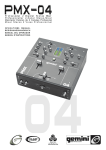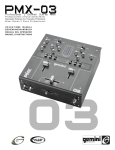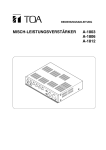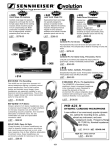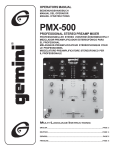Download 4U, 19" rack mounted mixer - Super Bocinas >>>>> Online
Transcript
4U, 19" rack mounted mixer 1 9 " R A C K M I X E R M I T 4 H E MEZCLADOR DE 4U, 19" FORMATO RACK MIXER RACKABLE 19'' X 4U OPERATIONS MANUAL BEDIENUNGSHANDBUCH MANUAL DEL OPERADOR MANUEL D’INSTRUCTIONS MULTI LANGUAGE INSTRUCTIONS ENGLISH..............................................................................................................................................................................................................................................................................PAGE 6 DEUTSCH............................................................................................................................................................................................................................................................................PAGE 9 ESPAÑOL........................................................................................................................................................................................................................................................................................................................................................................PAGE12 FRANCAIS....................................................................................................................................................................................................................................................................................................................................................................PAGE 15 PLEASE READ BEFORE USING APPLIANCE, IMPORTANT WARNING & SAFETY INSTRUCTIONS! CAUTION RISK OF ELECTRICAL SHOCK DO NOT OPEN! CAUTION: This product satisfies FCC regulations when shielded cables and connectors are used to connect the unit to other equipment. To prevent electromagnetic interference with electric appliances such as radios and televisions, use shielded cables and connectors for connections. regard to proper grounding of the mast and supporting structure, grounding of the lead-in wire to an antenna discharge unit, size of grounding conductors, location of antenna-discharge unit, connection to grounding electrodes, and requirements for the grounding electrode. See Figure B. The exclamation point within an equilateral triangle is intended to alert the user to the presence of important operating and maintenance (servicing) instructions in the literature accompanying the appliance. LIGHTENING: For added protection for this product during a lightening storm, or when it is left unattended and unused for long periods of time, unplug it from the wall outlet and disconnect the antenna or cable system. This will prevent damage to the product due to lightening and power-line surges. The lightening flash with arrowhead symbol, within an equilateral triangle, is intended to alert the user to the presence of uninsulated “dangerous voltage” within the product’s enclosure that may be of sufficient magnitude to constitute a risk of electric shock to persons. READ INSTRUCTIONS: All the safety and operating instructions should be read before the product is operated. POWER LINES: An outside antenna system should not be located in the vicinity of overhead power lines or other electric light or power circuits, or where it can fall into such power lines or circuits. When installing an outside antenna system, extreme care should be taken to keep from touching such power lines or circuits as contact with them might be fatal. RETAIN INSTRUCTIONS: The safety and operating instructions should be retained for future reference. OVERLOADING: Do not overload wall outlets, extension cords, or integral convenience receptacles as this can result in a risk of fire or electric shock. HEED WARNINGS: All warnings on the product and in the operating instructions should be adhered to. FOLLOW INSTRUCTIONS: All operating and use instructions should be followed. OBJECT AND LIQUID ENTRY: Never push objects of any kind into this product through openings as they may touch dangerous voltage points or short-out parts that could result in a fire or electric shock. Never spill liquid of any kind on the product. CLEANING: The product should be cleaned only with a polishing cloth or a soft dry cloth. Never clean with furniture wax, benzine, insecticides or other volatile liquids since they may corrode the cabinet. SERVICING: Do not attempt to service this product yourself as opening or removing covers may expose you to dangerous voltage or other hazards. Refer all servicing to qualified service personnel. ATTACHMENTS: Do not use attachments not recommended by the product manuacturer as they may cause hazards. DAMAGE REQUIRING SERVICE: Unplug this product from the wall outlet and refer servicing to qualified service personnel under the following conditions: WATER AND MOISTURE: Do not use this product near water, for example, near a bathtub, wash bowl, kitchen sink, or laundry tub; in a wet basement; or near a swimming pool; and the like. • When the power-supply cord or plug is damaged. ACCESSORIES: Do not place this product on an unstable cart, stand, tripod, bracket, or table. The product may fall, causing serious injury to a child or adult, and serious damage to the product. Use only with a cart, stand, tripod, bracket, or table recommended by the manufacturer, or sold with the product. Any mounting of the product should follow the manufacturer’s instructions, and should use a mounting accessory recommended by the manufacturer. • If the product has been exposed to rain or water. CART: A product and cart combination should be moved with care. Quick stops, excessive force, and uneven surfaces may cause the product and cart combination to overturn. See Figure A. • If the product has been dropped or damaged in any way. VENTILATION: Slots and openings in the cabinet are provided for ventilation and to ensure reliable operation of the product and to protect it from overheating, and these openings must not be blocked or covered. The openings should never be blocked by placing the product on a bed, sofa, rug, or other similar surface. This product should not be placed in a built-in installation such as a bookcase or rack unless proper ventilation is provided or the manufacturer’s instructions have been adhered to. • If liquid has been spilled, or objects have fallen into the product. • If the product does not operate normally by following the operating instructions. Adjust only those controls that are covered by the operating instructions as an improper adjustment of other controls may result in damage and will often require extensive work by a qualified technician to restore the product to its normal operation. • When the product exhibits a distinct change in performance, this indicates a need for service. REPLACEMENT PARTS: When replacement parts are required, be sure the service technician has used replacement parts specified by the manufacturer or have the same characteristics as the original part. Unauthorized substitutions may result in fire, electric shock, or other hazards. SAFETY CHECK: Upon completion of any service or repairs to this product, ask the service technician to perform safety checks to determine that the product is in proper operating condition. POWER SOURCES: This product should be operated only from the type of power source indicated on the marking label. If you are not sure of the type of power supply to your home, consult your product dealer or local power company. WALL OR CEILING MOUNTING: The product should not be mounted to a wall or ceiling. LOCATION: The appliance should be installed in a stable location. HEAT: The product should be situated away from heat sources such as radiators, heat registers, stoves, or other products (including amplifiers) that produce heat. NON-USE PERIODS: The power cord of the appliance should be unplugged from the outlet when left unused for a long period of time. GROUNDING OR POLARIZATION: • If this product is equipped with a polarized alternating current line plug (a plug having one blade wider than the other), it will fit into the outlet only one way. This is a safety feature. If you are unable to insert the plug fully into the outlet, try reversing the plug. If the plug should still fail to fit, contact your electrician to replace your obsolete outlet. Do not defeat the safety purpose of the polarized plug. • If this product is equipped with a three-wire grounding type plug, a plug having a third (grounding) pin, it will only fit into a grounding type power outlet. This is a safety feature. If you are unable to insert the plug into the outlet, contact your electrician to replace your obsolete outlet. Do not defeat the safety purpose of the grounding type plug. POWER-CORD PROTECTION: Power-supply cords should be routed so that they are not likely to be walked on or pinched by items placed upon or against them, paying particular attention to cords at plugs, convenience receptacles, and the point where they exit from the product. OUTDOOR ANTENNA GROUNDING: If an outside antenna or cable system is connected to the product, be sure the antenna or cable system is grounded so as to provide some protection against voltage surges and built-up static charges. Article 810 of the National Electrical Code, ANSI/NFPA 70, provides information with (2) PDM-0 01 Face REAR (3) PDM-02 Face REAR (4 4) PDM-0 03 60 Face REAR (5) INTRODUCTION: Congratulations on purchasing a Gemini PDM series 19"4U, 4 channel, rack mounted audio mixer. This state of the art mixer is backed by a 3 year warranty, excluding the cross fader. The cross fader is backed by a separate 90 day warranty. Prior to use, we suggest that you carefully read all the instructions. - Alternatively, the BALANCED MASTER (6) output jacks also connects the mixer to the main amplifier using standard cables with 1/4" TRS connectors. We recommend using balanced cables if the distance to your amp is 10 feet or more. - The BOOTH (7) output jacks allow the connection of an additional amplifier with RCA cables. FEATURES: - The ZONE (5) output jacks allow the connection of an additional amplifier with RCA cables. - 4U, 19" rack mounted mixer - 4 stereo channels - 7 lines, 3 Mic, 2 phono/line convertible RCA inputs - Master, record, booth, & zone RCA outputs - 1/4" balanced master output - 2 x 1/4" Mic inputs - Dual 10 band graphic EQ with on/off switch & blue LED indicator - Rotary zone, booth, & cue volume controls - Stereo/mono switch - Assignable cross fader - Removable, user replaceable Rail Glide cross fader - Push button cue section per channel with green LED indicator - CUE/PGM fader control allowing cue mix - XLR-1/4" combo Mic input - 2 band rotary Mic EQ & volume controls - Talk over feature - BNC lamp port - 1/4" headphone jack - The REC (4) output jacks can be used to connect the mixer to the record input of your recording unit, thus enabling you to record your mix. 4. Located on the rear panel are 2 PHONO (PH) /LINE (LN) convertible RCA inputs (12, 16), & 5 LINE RCA INPUTS (10, 9, 13, 17, 18). The convertible RCA inputs for CH 2 (16) & CH 3 (12) allow PH and LN level equipment to be connected to the mixer. To adjust the CONVERTER(s) (11, 15), just flip the switch UP to operate PH 1 or PH 2. Flip the switch DOWN to operate through LN 2 or LN 4. The PH INPUTS only accept turntables with a magnetic cartridge. When using (a) turntable(s), you will need to ground the RCA cable(s) by screwing in the grounding fork(s) to the GROUNDING SCREW (14) located in the back panel of the PDM mixers. This is located in between the CONVERTER SWITCHES (11, 15). The stereo LN INPUTS only accept line level inputs such as a CD, DAT, MiniDisc, etc. NOTE: WHEN USING TURNTABLES, NOT ATTACHING A GROUND MAY CAUSE A SYSTEM "HUM." 5. Headphones may be plugged into the face-plate located 1/4" HEADPHONE JACK (26). NOTE: ABOVE FEATURES INCLUDED IN EACH MODEL IN THE PDM SERIES. 6. The MIC 1 (49) input (located on the face panel) is a combination XLR & 1/4” connector. The MIC 2 (20) & MIC 3 (19) inputs (in the rear panel) accept only 1/4" connectors. The mic inputs accept balanced & unbalanced connections. PDM-01 FACE: - Master volume line fader control PDM-02 FACE: - 6 digital samples with volume, & speed rotary controls - Rotary master volume control - Master/Mic assignable echo effect switch with repeat & delay controls 7. The BNC LAMP PORT (22) (located on the face panel, above the POWER SWITCH (21)) is used to plug in a 12 V BNC goose neck lamp such as the Gemini GNL-700. PDM-03 FACE: OPERATING INSTRUCTIONS: - 24 second digital sampler comprised of 5 memory banks with soft touch backlit sample buttons - Rotary assignable channel control for sample recording - Sample parameter control with rotary level, pitch bend, record/play/stutter controls - Push button RoboPlay & cue sampler - Rotary master volume control PRECAUTIONS: 1. All operating instructions should be read before using this equipment. 2. To reduce the risk of electrical shock, do not open the unit. Please refer servicing to a qualified service technician. IN THE USA ~ IF YOU EXPERIENCE PROBLEMS WITH THIS UNIT CALL GEMINI CUSTOMER SERVICE AT: 1 (732) 738-9003. DO NOT ATTEMPT TO RETURN THIS EQUIPMENT TO YOUR DEALER. 3. Do not expose this unit to direct sunlight or to a heat source such as a radiator or stove. 4. This unit should be cleaned only with a damp cloth. Avoid solvents or other cleaning detergents. 5. When moving this equipment, it should be placed in its original carton and packaging. This will reduce the risk of damage during transit. 6. DO NOT EXPOSE THIS UNIT TO RAIN OR MOISTURE. 7. DO NOT USE ANY SPRAY CLEANER OR LUBRICANT ON ANY CONTROLS OR SWITCHES. 1. Once all of your connections have been made in the rear panel, turn ON the mixer by pressing the POWER SWITCH (21). Once turned ON, the POWER BAR LED, containing the power symbol located in the VU METER (23), will be illuminated. Turn OFF the mixer when not in use by pressing the POWER SWITCH (21) to OFF. When the PDM mixer is turned OFF the POWER BAR LED will not be illuminated. 2. CHANNEL (CH) 1: To bring this channel into program mix (PGM), you must first decide which LN will be in use. Use the LN SWITCH (37) to toggle from LN 1 (18) to MIC 3 (19) on this channel. Slowly raise the CH 1 SLIDE CONTROL (39) to a comfortable level, once you've selected the proper line. 3. CH 2: To bring this channel into PGM, you must first decide which LN will be in use. Use the LN SWITCH (40) to toggle from PH 1/LN 2 (16) to LN 3 (17) on this channel. Slowly raise the CH 2 SLIDE CONTROL (42) to a comfortable level, once you've selected the proper line. 4. CH 3: To bring this channel into PGM, you must first decide which LN will be in use. Use the LN SWITCH (43) to toggle from PN 2/LN 4 (12) to LN 5 (13) on this channel. Slowly raise the CH 3 SLIDE CONTROL (45) to a comfortable level, once you've selected the proper line. 5. CH 4: To bring this channel into PGM, you must first decide which LN will be in use. Use the LN SWITCH (46) to toggle from LN 6 (10) to LN 7 (9) on this channel. Slowly raise the CH 4 SLIDE CONTROL (48) to a comfortable level, once you've selected the proper line. 2. Located on the rear panel is the 115 V/230 V PLUG (2). Before plugging the power cord in, make sure the POWER SWITCH (21) located on the face panel is turned OFF. 3. The PDM mixers have 5 sets of outputs: 6. CUE: By connecting a set of headphones to the HEADPHONE (26) jack, you can monitor any or all channels. Press the CUE BUTTONS (38, 41, 44, 47) for CHs 1 through 4, respectively, to assign the CH(s) to be monitored. The respective CUE LED indicators will glow when in use. Use the rotary CUE VOLUME CONTROL (25) to adjust the CUE volume without changing the overall mix. By moving the CUE/PGM FADER CONTROL (24) to the LEFT you will be able to monitor the assigned CUE signal. Moving the CUE/PGM FADER CONTROL (24) to the MIDDLE allows CUE mix with PGM. Moving the CUE/PGM FADER CONTROL (24) to the RIGHT allows you to monitor PGM output. - The MASTER (3) output jacks connects to the main amplifier with RCA cables. 7. ASSIGN: There are 2 rotary controlled X FADER ASSIGN SWITCHES (34, 35), each having 5 settings OFF, 1, 2, 3, & 4. The LEFT (34) not CONNECTIONS: 1. Before plugging the power cord in, make sure that the VOLTAGE SELECTOR (1) switch is set to the correct voltage. (6) PDM SERIES ASSIGN switch allows you to direct CH 1, 2, 3, or 4 through the LEFT side of the CROSS FADER (36). The RIGHT ASSIGN (35) switch allows you to direct CH 1, 2, 3, or 4 through the RIGHT side of the CROSS FADER (36). When the ASSIGN SWITCH(es) (34, 35) are at OFF, you will not have a CH assigned to the CROSS FADER (36). This allows you to control the PGM with the use of the respective CH SLIDE CONTROLS, thus layering the PGM with up to four CHs. 8. CROSS FADER SECTION: The CROSS FADER (36) allows you to mix from one source to another. The PDM mixers feature an assignable CROSS FADER (36). The rotary controlled ASSIGN SWITCHES (34, 35) allow you to select which channel will play through each side of the CROSS FADER (36). The CROSS FADER (36) in your unit is removable & if the need arises can be easily replaced. Your Gemini mixer comes with a RG- 45 (RAILGLIDE™) DUAL-RAIL CROSS FADER. RAIL GLIDE™ CROSS FADERS have internal dual stainless steel rails that allow the slider to ride smoothly and accurately from end to end. Also available is our RG-45 PRO (PROGLIDE™) cross fader with a special curve designed for scratch mixing. Just purchase one from your Gemini dealer & follow the instructions: REPLACEABLE CROSS FADER 1. UNSCREW THE OUTSIDE FADER PLATE SCREWS (B). - DO NOT TOUCH INSIDE SCREWS (C). 2. CAREFULLY REMOVE OLD CROSS FADER AND UNPLUG CABLE (D). 3. PLUG IN THE NEW CROSS FADER INTO CABLE (D) AND PLACE BACK INTO MIXER. 4. SCREW THE CROSS FADER TO MIXER WITH THE FADER PLATE SCREWS (B). 9. EQUALIZER (EQ): These units feature dual 10 BAND GRAPHIC EQUALIZERS (32, 33) that will allow you to adjust the sound to fit any room. By adjusting any of the 10 EQ SLIDE CONTROLS (32, 33), you can cut or boost the tonal characteristics of the sound coming from PGM to the speaker(s) by ±12 dB. To activate the dual 10 BAND GRAPHIC EQ, switch the EQ SWITCH (31) to ON, & the EQ LED will light up to indicate that the EQ has been engaged. To deactivate the dual 10 band graphic EQ, switch the EQ SWITCH (31) to OFF, & the EQ LED will turn OFF. When activated, the EQ (32, 33) controls the LEFT and RIGHT side of your stereo speakers. The PGM & EQ are controlled by the MASTER VOLUME (27). To balance the sound of the PGM playing through the MASTER VOLUME (27) on the LEFT & RIGHT side of your speakers you must mirror the EQ levels on the LEFT (32) & RIGHT (33) EQ controls. NOTE: FOR OPTIMAL PERFORMANCE IN YOUR SOUND OUTPUT, HAVE YOUR SOUND SET TO STEREO NOT MONO. START WITH THE EQ LEVELS (32, 33) AT CENTER VALUE. THE EQ SLIDE CONTROLS (32, 33) SHOULD LOCK AT THIS POSITION. ADJUST YOUR MASTER VOLUME (27) CONTROL FROM MID TO LOW VOLUME RANGE. THEN ADJUST THE LEFT (32) OR RIGHT (33) EQ, ONE SLIDE CONTROL AT A TIME, TO A COMFORT ABLE LEVEL. ONCE YOU ARE SATISFIED WITH THE SOUND OF ONE SIDE, MATCH THE EQ SETTINGS ON THE OTHER SIDE. ONCE YOU HAVE PASSED THE CENTER VALUE ON THE EQ (32, 33), THE MASTER OUTPUT, AS INDICATED IN THE VU METER (23), MAY EXPERIENCE A TONAL BOOST. PLEASE ADJUST THE MASTER VOLUME (27) TO A COMFORTABLE LEVEL SO YOU DO NOT OVERLOAD YOUR SYSTEM. CLIPPING WILL OCCUR WHEN YOU ARE OVERLOADING YOUR SYSTEM. LOWER THE MASTER VOLUME (27) OR ADJUST YOUR EQ (32, 33) SETTINGS SO THAT CLIPPING DOES NOT OCCUR. THEN YOU MAY RAISE THE MASTER VOLUME (27) TO A LEVEL WITH WHICH YOU ARE COMFORTABLE. 10. STEREO/MONO: You can convert your sound output from STEREO to MONO & vice versa by using the STEREO/MONO SWITCH (30). Switch to the LEFT to convert to STEREO. Switch RIGHT to convert to MONO. 11. OUTPUT SELECTION CONTROL: Once you are comfortable with the sound level of your music you may adjust the decibel level of the PGM with the MASTER VOLUME (27) control. MASTER RCA & BALANCED MASTER OUTPUTS (3, 6) are controlled by the level of the MASTER VOLUME (27) control. You may adjust the volume of the ZONE (5) output with the ZONE (29) rotary control. You may adjust the volume of the BOOTH (7) output with the BOOTH (28) rotary control. The volume of your RECORD (4) output is controlled strictly by the CH SLIDE CONTROLS. 12. MIC SECTION: Plug your main MIC into the MIC 1 combination XLR-1/4" input (49) located on the face panel. The rotary controls for HIGH (52) and LOW (53) allow you to adjust the tone of MIC 1 (49). The rotary MIC 1 VOLUME CONTROL (50), above the rotary MIC 2 VOLUME CONTROL (51), adjusts the decibel level of MIC 1 (49). You may also plug a second & third MIC into the rear panel's MIC 2 (20) & MIC 3 (19) 1/4" jacks. The decibel level of MIC 2 (20) is controlled by the rotary MIC 2 VOLUME CONTROL (51). The decibel level of MIC 3 (19) is controlled by the CH 1 SLIDE CONTROL (39). (7 7) 13. TALKOVER: The purpose of the AUTO TALKOVER MODE is to allow the program playing to be attenuated so that the MIC may be heard above the music. The AUTO TALKOVER SWITCH (54) controls MIC 1 (49) and MIC 2 (20) with 3 settings: - When the MIC/TALKOVER SWITCH (54) is in the BOTTOM position, MIC 1 (49), MIC 2 (20) & TALKOVER MODE are all OFF. - When the MIC/TALKOVER SWITCH (54) is in the CENTER position, MIC 1 (49) & MIC 2 (20) are ON & TALKOVER MODE is OFF. The MIC ON LED indicator glows when MIC 1 (49) & MIC 2 (20) are ON. - When the MIC/TALKOVER SWITCH (54) is in the TOP position, MIC 1 (49) & MIC 2 (20) are ON, TALKOVER MODE is ON, & the volume of all sources except MIC 1 (49) & MIC 2 (20) are lowered automatically by -16 dB, when speaking into the MIC(s). 14. BNC LAMP PORT: The BNC LAMP PORT (22) connects a 12 V BNC goose neck lamp, such as the Gemini GNL-700 to the PDM mixer. The goose neck lamp will be powered by your mixer. To turn ON the goose neck lamp, you must first attach the goose neck lamp to the BNC LAMP PORT (22). Make sure the PDM mixer is OFF when connecting the 12 V BNC lamp. To connect the goose neck lamp, simply align the screw cap of the goose neck lamp to the locking nodules of the BNC LAMP PORT (22), push down, & twist the screw cap clockwise to lock the 12 V BNC goose neck lamp in place. Then turn ON your mixer. The goose neck lamp should light-up. To detach the goose neck lamp from the BNC LAMP PORT (22), first make sure your mixer is OFF. Turn OFF your mixer and the goose neck lamp will turn OFF. Unscrew the screw cap by twisting it counterclockwise, then pull up & remove the goose neck lamp. 15. GROUND LIFT SWITCH: The GROUND LIFT SWITCH (8) is used to reduce background noise & hum when using multiple outlets to power audio equipment. The switch should be in the position that provides the least amount of noise or hum. If noise remains at the same level in both positions, the GROUND LIFT SWITCH (8) should be kept in the GND position. NOTE: MAKE SURE THE MIXER AND/OR AMPLIFIER IS OFF BEFORE SWITCHING THE GROUND LIFT SWITCH TO PREVENT A TRANSIENT POP THAT MAY DAMAGE YOUR SYSTEM. 16. VU METER: The VU METER (23) indicates the decibel level of the MASTER RCA & MASTER BALANCED (3 & 6) outputs of the LEFT & RIGHT stereo levels. PDM-02 ECHO/EFX: ECHO SECTION: An echo effect may be applied to the PGM, or MIC 1 (49) & MIC 2 (20) signals by switching the ECHO (55) switch from MIC 1-2 on the LEFT, to OFF in the MIDDLE, to MASTER on the RIGHT & vice versa. When using ECHO (55), you may adjust the effect of the ECHO (55) by using the rotary REPEAT (56), DELAY (57), and ECHO VOLUME (58) controls. To turn the ECHO (55) OFF, lower the ECHO VOLUME (58) or switch the ECHO (55) switch to OFF. SOUND EFFECTS SECTION: Six different sound effects (APPLAUSE, SCREAM, COPTER, SCRATCH, H2O & GLASS) may be added to your mix by pressing the SOUND EFFECTS CONTROL BUTTONS (61). The volume of the effects can be adjusted using the rotary EFX VOLUME (60) located above the APPLAUSE effect button. The pitch of the effects can be increased or decreased using the rotary SPEED CONTROL (59) located above the SCRATCH effect button. PDM-03 SAMPLER OPERATION: MEMORY INFORMATION: The PDM-03 is equipped with 5 MEMORY BANKS (59). The two banks marked 2 & 2 are two seconds in length, the two banks marked 4 & 4 are four seconds in length and the bank marked 12 is twelve seconds in length. These banks are separate & CANNOT be linked. You can store a different sample in each bank, but they must be recorded individually & must be played one at a time. SAMPLE RECORDING: 1. Select the sample source by switching to the appropriate channel with the rotary SAMPLER ASSIGN (55) control. 2. The PDM-03 comes equipped with a rotary sampler PITCH CONTROL (56). To get a "perfect" sample, set the control to its CENTER position & record the sample. Raising or lowering the control during playback raises or lowers the pitch of the sample. The CENTER position retains the "normal" pitch. 5. The SAMPLER LEVEL (57) controls the decibel level of the sample. This feature allows you to adjust the volume of the sample to play over or under PGM. HINT: YOU CAN RECORD A SAMPLE WITH THE PITCH CONTROL IN ANY POSITION. WHATEVER THAT POSITION IS WILL BECOME NORMAL SOUND. IF YOU START TO RECORD A SAMPLE WITH THE PITCH CONTROL SET AT "MINIMUM" THAT WILL BECOME YOUR NORMAL PITCH. BY INCREASING THE PITCH TO "MAXIMUM" DURING PLAYBACK, THE PITCH EFFECT WILL DOUBLE IN SPEED. RECORDING AT "MAXIMUM" AND LOWERING TO "MINIMUM" DURING PLAYBACK WILL DO EXACTLY THE OPPOSITE. 1. BATTERY BACKUP: The PDM-03 is equipped with battery backup to retain samples. To activate this feature, a 9 V battery (not included) should be connected to the BATTERY HOLDER (60) located on the rear panel. This enables the storage of samples in memory. When the unit is unplugged, the battery backup retains the samples for future use. 3. Put the MODE SELECTOR (58) switch into the RECORD position. 4. Listen to the channel to be recorded in cue, by selecting the appropriate CUE button for this channel. When the track approaches the section to be sampled, press the proper MEMORY BANK (59) button.where you want the sample to be stored. 5. Then press the SAMPLER (59) button to start recording the sample. The Memory bank in use will have a blinking LED, if a battery is not in place or the battery is low (See BATTERY BACKUP section). The sample will be stored in this MEMORY BANK (59) & ready to play. NOTE: TAPPING THE SAMPLER BUTTON BEGINS THE SAMPLING PROCESS (THE SAMPLER INDICATOR WILL "GLOW" BLUE). TAPPING THE SAMPLER BUTTON A SECOND TIME ENDS THE SAMPLE (THE SAMPLER INDICATOR WILL TURN OFF). IF YOU DO NOT TAP THE SAMPLER BUTTON A SECOND TIME, THE SAMPLING PROCESS STOPS AUTOMATICALLY AFTER 2, 4 OR 12 SECONDS DEPENDING ON WHICH MEMORY BANK WAS SELECTED. CUE SAMPLER: To test the recorded sample before playing in PGM, press the CUE SAMPLER (59) button, placing the sampler in CUE. Use the CUE controls to monitor this sample. The CUE SAMPLER LED will illuminate 5. If you are satisfied with your sample, leave it stored in the MEMORY BANK. If not, please repeat the steps for SAMPLE RECORDING. SAMPLE PLAYBACK: 1. Set the MODE SELECTOR (58) switch to PLAY or STUTTER. 2. Select the desired sample by pressing the proper MEMORY BANK button. 3. Tapping the SAMPLER button with the MODE SELECTOR (58) switch in the PLAY position causes SAMPLER to play back one time (the SAMPLER INDICATOR will "glow" BLUE). Each push of the SAMPLER button restarts the sample from the beginning. Rapid pressing of the SAMPLER button will cause a stuttering effect. Once the sample has started playback & the SAMPLER button is not pushed a second time, the SAMPLE will PLAY to the end & stop. 4. Tapping the SAMPLER (55) button with the MODE SELECTOR (58) switch in the STUTTER position causes the SAMPLE to loop play continuously. In STUTTER mode, the SAMPLER button acts an ON/OFF switch. The first push starts the sample, the second push stops it. (8) BATTERY BACKUP: NOTE: IF THE UNIT IS UNPLUGGED WITH NO BATTERY ATTACHED, ALL SAMPLES WILL BE LOST. 2. LOW BATTERY INDICATOR: When the selected memory bank LED blinks, this will indicate that there is a low battery or no battery in the PDM-03. The LED blinks a warning if no battery is connected to the PDM-03. When changing or placing the battery into the PDM-03, make sure the unit is plugged in and the power is ON. Failure to adhere to this will result in lost memory and "vanished" samples. SPECIFICATIONS: INPUTS: Phono:.................................................................................3 mV, 47 KOhm Line:................................................................................150 mV, 27 KOhm MIC 1, 2, & 3:...................................................1.5 mV, 2 K Ohm Balanced Bass:.................................................................................................± 12dB High:..................................................................................................± 12dB OUTPUTS: Amp/Booth:.....................................................................0 dB 1V, 400 Ohm Max:................................................................................20V Peak-to-Peak Rec....................................................................................225 mV, 5 KOhm Zone.................................................................................0dB 1V 400 Ohm Balanced...........................................................................6dB 2V 400 Ohm GENERAL: Frequency Response:..............................................20Hz - 20KHz +/- 2 dB Distortion:...........................................................................................0.02% S/N Ratio:........................................................................Better Than 80 dB Talkover Attenuation:.........................................................................-16 dB Headphone Impedance:..................................................................16 Ohm Power Source:......................................................115/230V, 50/60Hz, 10W Unit Dimensions:........................................................W 19" x H 4" x D 8.6" .......................................................................(482.6 x 101.6 x 218.44 mm) Weight:............................................................................... 10.1 lbs (4.7kg) SPECIFICATIONS SUBJECT TO CHANGE WITHOUT NOTIFICATION FOR IMPROVEMENT. PDM SERIES EINFÜHRUNG: Vielen Dank, daß Sie sich für einen GEMINI Mixer aus der Serie PDM entschieden haben. Diese Serie besteht aus 3 Mixern mit unterschiedlichen Features und ist für 19” 4HE-Rackeinbau vorgesehen. Die Mischpulte sind nach dem neuesten Stand der Technik hergestellt und mit einer Garantie von 3 Jahren versehen. Der Cross fader hat eine Garantie von 2 Jahren. Bitte lesen Sie alle Anweisungen vor der Inbetriebnahme sorgfältig durch AUSSTATTUNG: - 2. Die NETZANSCHLUßBUCHSE (2) befindet sich an der Rückseite. Achten Sie vor dem Anschluß des Netzkabels darauf, daß der Netzschalter POWER SWITCH (21) auf der Frontplatte ausgeschaltet ist 3. Die PDM-Mixer sind miit 5 Ausgängen ausgestattet: - Die Cinchbuchsen MASTER (3) dienen zum Anschluß an den Hauptverstärker mit kurzen Kabeln. - Alternativ sind die Klinkenbuchsen BALANCED MASTER (6) zum Anschluß des Hauptverstärkers mit symmetrischen Kabeln für Längen ab 3m vorgesehen. - Die Cinchbuchsen BOOTH (7) und ZONE (5) sind als Ausgänge für zusätzliche Verstärker oder Aktivboxen ausgelegt. 19" Rackmixer mit 4 HE 4 Stereo Kanäle 7 Line-, 3 Mic.-, und 2 umschaltbare Phono/Line Cincheingänge Cinchausgänge für Master, Record, Booth, & Zone Symmetrische Masetrausgänge mit 6,3mm Klinkenbuchsen 2 x Mikrofoneingänge mit 6,3mm Klinkenbuchsen - Um Ihren Mix aufnehmen zu können, schließen Sie Ihren Recorder (DAT, MD, PC) an die Cinchbuchsen REC (4) Output an. FRONTPLATTE: - Stereo 10 Band graphischer Equalizer mit Ein/Aus-Schalter und blauer LED - Drehregler für Zone-, Booth-, & Cue-Volume - Stereo/Mono Schalter - Zuweisbarer Crossfader - Einfach auszutauschender Rail Glide Crossfader - Cuesektion mit Drucktastern und grüner LED pro Kanal - CUE/PGM-Fader für Cue-Mix - XLR/Klinkenkombibuchse für Mikrofonanschluß - Mikrofoneingang mit 2 Band Equalizer & Volume Drehreglern - Talk over Funktion - BNC-Buchse für 12V Lampenanschluß - 6,3mm Klinkenbuchse für Kopfhörer 4. An der Rückwand befinden sich 2 umschaltbare PHONO (PH) /LINE (LN) Cincheingänge (12, 16), & 5 LINE Cincheingangsbuchsen (10, 9, 13, 17, 18). Die umschaltbaren Eingänge für CH 2 (16) & CH 3 (12) dienen zum gleichzeitigen Anschluß von Plattenspielern mit Magnetsystem PH und z.B. CD-Playern LN. Schalter (11) oben für PHONO 1 oder 2; Schalter (11&15) unten für LINE 2 oder 4. Beim Anschluß einens Plattenspielers, achten Sie darauf, daß das Massekabel (Erdung) an die Schraube GROUNDING SCREW (14) zwischen den Schalter (11&15) an der Rückwand des PDM Mixers angeschlossen wird. An die Stereocincheingänge LN INPUTS können die Ausgänge von CD, DAT, MiniDisc, MP-3 etc angeschlossen werden. ANMERKUNG: WIRD BEIM ANSCHLUß EINES PLATTENSPIELERS, DIE MASSELEITUNG NICHT ANGESCHLOSSEN, KANN EIN BRUMMGERÄUSCH AUFTRETEN! 5. Kopfhörer können an die 6.3 mm Klinkenbuchse HEADPHONE JACK (26) auf der Frontplatte angeschlossen werden. 6. Der MIC 1 (49) iEingang auf der Frontplatte ist als XLR/Klinkenkombibuchse ausgeführt. Die Eingänge MIC 2 (20) & MIC 3 (19) auf der Rückwand haben je eine 6.3 mm Klinkenbuchse und sind für symmetrische und unsymmetrische Mikrofone geeignet. ANMERKUNG: OBEN GENANNTE FEATURES SIND FÜR ALLE PDM MIXER GLEICH. PDM-01 FRONTPLATTE: - Fader für Master Volume PDM-02 FRONTPLATTE: - 6 digital Sampleeffekte mit Drehreglern fürVolume und Geschwindigkeit - Drehregler für Master Volume - Echo-Effektschalter, zuweisbar auf Master/Mic mit Reglern für Repeat und Delay PDM-03 FRONTPLATTE: - 24 Sekunden Digitalsampler mit 5 Speicherbänken und beleuchteten Softtouch Tastern - Kanäle per Drehschalter auf den Samplereingang zuweisbar - Samplersektion mit Drehreglern für Parameter, Pegel, Pitch bend; unr Tastern für Record/Play/Stutter - Druckschalter für RoboPlay und Cue Sampler - Drehregler für Master Volume VORSICHTSMAßNAHMEN: 1. Vor der Anwendung des Mixers, bitte alle Anweisungen durchlesen. 2. Um einen elektrischen Schock zu vermeiden, das Gerät nicht öffnen. Servicearbeiten dürfen nur qualifizierten Wartungstechnikern durchgeführt werden. 3. Setzen Sie das Gerät nie direkter Sonneneinstrahlung oder Hitzequellen(Heizstrahler o.ä.) aus. 4. Reinigen Sie die Oberflächen nur mit einem weichen Tuch. Keine scharfen Reinigungsmittel verwenden. 5. Transportieren Sie den Mixer möglichst im Originalkarton, um Schäden zu vermeiden. 6. SETZEN SIE DIESES GERÄT NIE REGEN ODER STARKER FEUCHTIGKEIT AUS. 7. VERWENDEN SIE KEIN KONTAKT-, ÖL-, ODER SILIKONSPRAY AN DEN SCHALTERN, REGLERN, UND FADERN. ANSCHLÜSSE: 1. Bevor Sie das Netzkabel anschliessen, vergewissern Sie sich, das der Spannungswahlschalter VOLTAGE SELECTOR (1) auf die richtige Netzspannung eingestellt ist. (9) 7. Über dem Netzschalter POWER SWITCH (21) auf der Frontplatte, ist eine BNC-Buchse (22) zum Anschluß einer 12V-5W Schwanenhalslampe (z.B. Gemini GNL-700) angebracht. BEDIENUNG: 1. Wenn alle Verbindungen hergestellt sind, schalten Sie den Mixer mit dem POWER SWITCH (21) ein. Die im VU METER (23) befindliche Power LED leuchtet auf. Wenn Sie den Mixer nicht benutzen, schalten Sie den POWER SWITCH (21) wieder aus. Die LED geht wieder aus.. 2. KANAL 1 (CH) 1: Um diesen KANAL im Mix (PGM zu hören, wählen Sie zuerst das Eingangssignal mit dem LN SWITCH (37) LN 1 (18) oder MIC 3 (19). Schieben Sie nun den Fader CH 1 SLIDE CONTROL (39) hoch, bis der gewünschte Pegel erreicht ist. 3. KANAL 2 (CH) 2: Um diesen Kanal im Mix (PGM zu hören, wählen Sie zuerst das Eingangssignal mit dem LN SWITCH (40) PH 1/LN 2 (16) oder LN 3 (17). Schieben Sie nun den Fader CH 2 SLIDE CONTROL (42) hoch, bis der gewünschte Pegel erreicht ist. 4. KANAL 3 (CH) 3: Um diesen Kanal im Mix (PGM zu hören, wählen Sie zuerst das Eingangssignal mit dem LN SWITCH (43) PH 2/LN 4 (12) oder LN 5 (13). Schieben Sie nun den Fader CH 1 SLIDE CONTROL (45) hoch, bis der gewünschte Pegel erreicht ist. 5. KANAL 4 (CH) 4: Um diesen Kanal im Mix (PGM zu hören, wählen Sie zuerst das Eingangssignal mit dem LN SWITCH (46) LN 6 (10) oder LN 7 (9). Schieben Sie nun den Fader CH 1 SLIDE CONTROL (48) hoch, bis der gewünschte Pegel erreicht ist. 6. CUE (Vorhören): Wenn Sie einen Kopfhörer an die Buchse HEADPHONE (26) anschließen, können Sie alle Kanäle Vorhören. Drücken Sie die Knöpfe CUE BUTTONS (38, 41, 44, 47) für Kanal 1 bis 4, um den abzuhörenden Kanal anzuwählen. Die jeweils zugehörige LED leuchtet auf. Mit dem Drehregler CUE VOLUME CONTROL (25) regeln Sie die Vorhörlautstärke , unabhängig von Ihrem Mix. Bewegen Sie den CUE/PGM FADER (24) nach links, hören Sie das CUE Signal. Schieben Sie den CUE/PGM FADER (24) in die Mitte, hören Sie CUE gemischt mit PGM. Ist der CUE/PGM FADER (24) nach rechts geschoben, hören Sie PGM (Mixsignal (Bus) vor dem MASTER-OUT. 7. ASSIGN: Auf der Frontplatte befinden sich zwei Drehschalter X FADER ASSIGN SWITCHES (34, 35), mit 5 Stellungen: OFF, 1, 2, 3, & 4. Der linke SCHALTER ASSIGN (34) schaltet die KANÄLE CH 1, 2, 3, or 4 auf die linke Seite des CROSS FADERS (36). Der rechte SCHALTER ASSIGN (35) schaltet die KANÄLE CH 1, 2, 3, or 4, auf die rechte Seite des CROSS FADERS (36). Sind die SCHALTER ASSIGN (34, 35) auf OFF gestellt, wird kein Signal auf den CROSS FADER (36) geleitet. Abhängig von der Stellung des jeweiligen KANALFADERS KANAL 1 bis 4, sind somit alle 4 KANÄLE im PGM-Mix hörbar. 8. CROSS FADER SEKTION: Der CROSS FADER (36) ermöglicht das Überblenden von einerm Eingang zum Anderen. Die PDM Mixer sind wie in PUNKT 7 (ASSIGN) beschrieben mit einem zuweisbaren CROSS FADER (36) ausgestattet. Er ist leicht herausnehmbar und kann dadurch schnell ausgetauscht werden. Ihr Gemini Mixer wird mit einem RG- 45 (RAILGLIDE™) DUAL-RAIL CROSS FADER geliefert. RAIL GLIDE™ CROSS FADER haben intern zwei Edelstahlschienen, die ein sanftes und genaues Gleiten von einem Ende zum Anderen ermöglichen. Alternativ ist der Einbau des RG-45 PRO (PROGLIDE™) CROSS FADERS mit einer Spezialkurve für das Scratchen möglich.with a special curve designed for scratch mixing. Beachten Sie zum Austauschen folgende Anleitung: CROSSFADER AUSTAUSCH: - Ist der Schalter MIC/TALKOVER (54) in der unteren Position, sind MIC 1 (49), MIC 2 (20) & TALKOVER MODE aus. - Befindet sich der Schalter MIC/TALKOVER (54) in der Mitte, sind MIC 1 (49) & MIC 2 (20) an & TALKOVER MODE is aus. Die MIC ON LED wenn MIC 1 (49) & MIC 2 (20) an sind. - Mit dem Schalter MIC/TALKOVER (54) in der oberen Position, sind MIC 1 (49) & MIC 2 (20) an und der TALKOVER MODE ist aktiviert. Der Musikpegel der anderen Eingange wird automatisch um, -16 dB, wenn in MIC 1 (49) oder MIC 2 (20) gesprochen wird. 14. BNC LAMPEN ANSCHLUß: Die Buchse BNC LAMP PORT (22) dient zum Anschuß einer Schwannenhalslampe (12V-5W) wie z.B. die Gemini GNL-700. Schließen Sie die Lampe nur an, wenn Ihr Mixer ausgeschaltet ist. Stecken Sie den BNC-Stecker vorsichtig auf die BNCBuchse und drehen Sie die Überwurfmutter (Bajonettverschluß) im Uhrzeigersinn, um den Stecker zu verriegeln. Wenn Sie jetzt den Mixer einschalten leuchtet die Lampe auf. Um die Lampe wieder zu entfernen, schalten Sie zuerst den Mixer aus, lösen dann den BNC-Stecker entgegen dem Uhrzeigersinn und ziehen die Lampe wieder ab. 15. GROUND LIFT SCHALTER: Der Schalter GROUND LIFT SWITCH (8) wird eingesetzt um Brummgeräusche zu vermeiden. Überprüfen Sie, in welcher Stellung die geringsten Störgeräusche hörbar sind und belassen Sie den Schalter GROUND LIFT SWITCH (8) in dieser Stellung. Ist kein Störgeräusch vorhanden, oder in beiden Stellungen des Schalters GROUND LIFT SWITCH (8) gleich, so lassen Sie den Schalter in der Position GROUND. 1. DIE ÄUßEREN SCHRAUBEN DER CROSSFADERPLATTE (B) LOSSCHRAUBEN.. NICHT DIE INNENSCHRAUBEN (C) LÖSEN. 2. DEN ÜBERBLENDER VORSICHTIG ANHEBEN UND DAS KABEL (D) ABZIEHEN. 3. DAS KABEL AUF DEN NEUEN FADER STECKEN UND WIEDER IN DAS MISCHPULT SETZEN. ANMERKUNG: STELLEN SIE SICHER, DAS MIXER UND VERSTÄRKER AUSGESCHALTET SIND; BEVOR SIE DEN GROUND LIFT SCHALTER BETÄTIGEN. DAS SCHALTGERÄUSCH KÖNNTE SONST IHRE ANLAGE BESCHÄDIGEN. 4. DEN NEUEN CROSSFADER MIT DEN SCHRAUBEN AM MISCHPULT BEFESTIGEN. 9. KLANGREGELUNG EQUALIZER (EQ): Die PDM-Mixer haben zur Klangregelung zwei 10 BAND GRAPHIC EQUALIZER (32, 33) eingebaut. Bewegen Sie einen der Fader nach oben oder unten, so wird der jeweilige Frequenzbereich um + 12 dB angehoben bzw. abgesenkt. Der zweifach 10 BAND GRAPHIC EQ, wird mit dem Schalter EQ SWITCH (31) Ein- und Ausgeschaltet. Dies wird durch die EQ.-LED signalisiert. Ist der EQ aktiviert, werden beide PGM-KANÄLE damit beinfllußt. Der gemeinsame Ausgangspegel wird mit MASTER VOLUME (27) geregelt. Um eine gleichmäßige Balance des Ausgangssignals zu erreichen, müssen beide EQ`s (32 & 33) gleich eingestellt sein (gespiegelt). ANMERKUNG: FÜR OPTIMALE KLANGQUALITÄT MIXEN SIE IMMER IN STEREO NICHT IN MONO: BEGINNEN SIE MIT DEN EQ PEGELN (32, 33) IN DER MITTE(REGLER EINGERASTET). DREHEN SIE DEN MASTER VOLUME (27) REGLER IN DEN UNTEREN BEREICH. STELLEN SIE NUN DEN LINKEN(32) UND RECHTEN(33) KANAL DES EQUALIZERS NACHEINANDER EIN, SIND SIE MIT DER KLANGEINSTELLUNG ZUFRIEDEN, ÜBERPRÜFEN SIE, OB BEIDE EQ-KANÄLE GLEICH EINGESTELLT SIND. JEDE VERÄNDERUNG IM EQ(32&33) MACHT SICH AUCH ALS PEGELÄNDERUNG IM MASTER AUSGANG UND IM VU-METER(23) BEMERKBAR. STELLEN SIE JETZT MIT MASTER VOLUME (27) DEN GEWÜNSCHTEN AUSGANGSPEGEL EIN OHNE IHREN MIXER UND DAS GESAMTSYSTEM ZU ÜBERLASTEN. ES DÜRFEN KEINE VERZERRUNGEN DURCH ZU HOHE PEGEL AUFTRETEN, DA SONST VERSTÄRKER UND/ODER LAUTSPRECHER ZERSTÖRT WERDEN KÖNNEN. 10. STEREO/MONO: Mit dem Schalter STEREO/MONO (30) nach links, wird das Ausgangssignal in Stereo wiedergegeben. Legen Sie den SCHALTER (30) STERO/MONO nach rechts, ist der Ausgang auf Mono geschaltet. 11. FUNKTION UND REGELUNG DER AUSGÄNGE (OUTPUTS): Wenn sie mit Ihrem Sound zufrieden sind, können Sie den PGM-Pegel mit dem Regler MASTER VOLUME (27) einstellen. Die beiden Ausgänge: MASTER (Cinch, unsymmetrisch) und BALANCED MASTER (Klinke, symmetrisch) (3, 6) werden mit dem Regler MASTER VOLUME (27) geregelt. Der Ausgang ZONE (5) wird mit dem Drehregler ZONE (29) eingestellt. Den Ausgang BOOTH (7) verändern Sie mit dem Drehregler BOOTH (28). Der RECORD (4) Ausgang ist nur von den Kanalfadern abhängig und nicht getrennt regelbar. 12. MIC SEKTION: Stecken Sie den Stecker Ihres Hauptmikrofons in die MIC 1 KOMBIBUCHSE (49) auf der Frontplatte. Mit den Drehreglern HIGH (52) und LOW (53) verändern Sie den Klang Ihres Hauptmikrofons. Der Drehregler MIC 1 VOLUME CONTROL (50) regelt den Pegel. Zwei weitere Mikrofone können an die Klinkenbuchsen MIC 2 (20) & MIC 3 (19) an der Rückwand angeschlossen werden. Der Pegel von MIC 2 (20) ist mit dem Drehregler MIC 2 VOLUME CONTROL (51) einstellbar. MIC 3 (19) wird mit dem KANALFADER 1 CH 1 SLIDE CONTROL (39) geregelt. 13. TALKOVER: Um das Mikrofon bei laufender Musik besser hören zu können, schalten Sie die AUTO TALKOVER FUNKTION ein. Der Schalter AUTO TALKOVER (54) wirkt auf MIC 1 (49) und MIC 2 (20) und hat 3 Stellungen: (10) 16. VU METER (AUSSTEUERUNGSANZEIGE): Das VU METER (23) zeigt in dB den Stereoausgangspegel der MASTERAUSGÄNGE (3 & 6) an. PDM-02 ECHO/EFX: ECHO SEKTION: Der Echo-Effekt kann mit dem Schalter ECHO (55) auf PGM, oder MIC 1 (49) & MIC 2 (20) geschaltet werden. Schalten Sie nach links geht der Effekt zum PGM, in der Mitte ist Echo abgeschaltet und schalten Sie nach rechts geht der Effekt auf MIC 1 (49) & MIC 2 (50). Mit den Drehreglern REPEAT (56), DELAY (57), and (58) wird der ECHOEFFEKT eingestellt. SOUND EFFEKT SEKTION: Sechs verschiedene SOUND-EFFECTE (APPLAUSE, SCREAM, COPTER, SCRATCH, H2O & GLASS) können dem Mix hinzugefügt werden. Sie sind mit den Tastern SOUND EFFECTS CONTROL BUTTONS (61) anwählbar.Der Pegel wird mit EFX VOLUME (60) geregelt, welcher sich über dem APPLAUSE Tadter befindet. Die Tonhöhe (Pitch) der Effekte kann mit dem Drehregler SPEED CONTROL (59) (über dem SCRATCH Taster) eingestellt werden. PDM-03 SAMPLER BEDIENUNG: SPEICHERBÄNKE: Der PDM-03 hat 5 SPEICHERBÄNKE MEMORY BANKS (59). Die beiden mit 2 & 2 bezeichneten Bänke speichern je 2 sek, die beiden mit 4 & 4 bezeichneten Bänke speichern je 4 sek. und die mit 12 bezeichnete Bank speichert 12 sek.. Die Speicherbänke sind immer nur einzeln anwählbar und können nicht zusammengefaßt werden. Jede Bank kann ein anderes Sample enthalten, muß dazu aber separat gesampelt und auch wieder einzeln abgespielt werden. SAMPLE RECORDING: 1. Wählen Sie mit dem Drehschalter SAMPLER ASSIGN (55) den gewünschten Eingang aus. 2. Drehen Sie den Drehregler PITCH CONTROL (56) in die Mitte um mit normaler Tonhöhe aufzunehmen. HINWEIS: SIE KÖNNEN EINEN SAMPLE IN JEDER STELLUNG DES PITCHREGLERS AUFNEHMEN. DIESE STELLUNG IST DANN DIE NORMALPOSITION.. BEISPIEL: NEHMEN SIE EINEN SAMPLE IN POSITION GANZ LINKS AUF UND SPIELEN DEN SAMPLE IN POSITION GANZ RECHTS WIEDER AB, VERDOPPELT SICH DIE ABSPIELGESCHWINDIGKEIT UND UMGEKEHRT. PDM SERIES 3. Schalten Sie den MODE SELECTOR (58) in die RECORD Position. 4. Hören Sie den ausgewählten Kanal ab, indem Sie den CUE SCHALTER für diesen Kanal drücken und wählen Sie eine Speicherbank MEMORY BANK (59) aus. 5. Ist die Stelle erreicht, die Sie sampeln wollen, drücken Sie die Taste SAMPLER (59). Die gewählte Speicherbank LED blinkt, wenn keine BACK-UP BATTERIE eingebaut bzw. diese leer ist (siehe Back-up Batterie). Das Sample wird in der Speicherbank MEMORY BANK (59) gespeichert und kann wieder abgespielt werden. ANMERKUNG: DAS DRÜCKEN DER SAMPLETASTE STARTET DEN SAMPLEPROZESS(SAMPLER LED LEUCHTET BLAU) NOCHMALIGES DRÜCKEN DER SAMPLETASTE BEENDET DEN PROZESS(SAMPLER LED ERLISCHT WIEDER). WIRD DIE TASTE NICHT WÄHREND DES SAMPELNS GEDRÜCKT, SO ENDET DER PROZESS NACH ABLAUF DER JEWEILIGEN ZEIT(2, 4, ODER 12SEK.) SAMPLER CUE (VORHÖREN): 1. Drücken Sie den Knopf CUE SAMPLER (59) um den aufgenommenen Sample vorzuhören. Die CUE SAMPLER LED leuchtet dann auf. 2. Schalten Sie den Schalter MODE SELECTOR (58) auf PLAY oder STUTTER. 3. Wahlen Sie die gewünschte Speicherbank MEMORY BANK aus. 4. Drücken Sie den beleuchteten Taster SAMPLER um den Sample abzuhören. Erneuted Drücken der Taste SAMPLE stoppt das Abspielen. 5. Sind Sie mit dm Sample nicht zufrieden wiederholen Sie den Vorgang (Pos. 1-5). SAMPLE PLAYBACK (WIEDERGABE): 1. Schalten Sie den Schalter MODE SELECTOR (58) auf PLAY oder STUTTER. 2. Wahlen Sie die gewünschte Speicherbank MEMORY BANK aus. 3. Drücken Sie den beleuchteten Taster SAMPLER (SAMPLER LED leuchtet blau) um den Sample abzuhören. Jedes Drücken der Taste startet gen Abspielvorgang neu. Schnelles, wiederholtes Drücken ergibz einen Stuttereffek. Wird die Taste SAMPLE nach dem starten nicht nochmals gedrückt spielt der Sampler bid zum Ende des Sampels weiter. 4. Drücken Sie die Taste SAMPLER (55) während der Schalter MODE SELECTOR (58) in der STUTTER Position steht, wird das Sample wie ein Loop (Schleife) endlos abgespielt, solange, bis die Taste SAMPLE erneut gedrückt wird. (11) 5. Der Drehregler SAMPLER LEVEL (57) dient zur Pegeleinstellung des Samplesignals. Dadurch ändern Sie das Verhältnis des Samplesignals zum PGM-Signal. BATTERY BACKUP (PUFFER-BATTERIE): 1. BATTERY BACKUP: Um die gespeicherten Samples nicht nach dem Ausschalten des Mixers zu verlieren, ist der PDM-03 mit einem Fach für eine Pufferbatterie versehen. Eine 9 V BLOCKBATTERIE (not included) muß in den BATTERY HOLDER (60) (Batteriefach) an der Rückwans eingesetzt und angeschlossen werden. ANMERKUNG: WIRD DER MIXER ABGESCHALTET/ABGEKABELT OHNE DAS EINE PUFFERBATTERIE EINGESETZT IST, WERDEN ALLE SAMPLES GELÖSCHT. 2. LOW BATTERY INDICATOR (ANZEIGE: BATTERIE LEER): Blinkt die LED der angewählten Speicherbank, so ist keine Pufferbatterie eingesetzt oder diese ist leer. Wechseln Sie die Batterie bei eingeschaltetem Mixer, da sonst die Speicherbänke gelöscht werden. TECHNISCHE DATEN: EINGÄNGE: Phono:.................................................................................3 mV, 47 KOhm Line:................................................................................150 mV, 27 KOhm MIC 1, 2, & 3:...................................................1.5 mV, 2 K Ohm Balanced Bässe:...............................................................................................± 12dB Höhen:..............................................................................................± 12dB AUSGÄNGE: Amp/Booth:.....................................................................0 dB 1 V, 400 Ohm Max:................................................................................20 V Spitze-Spitze Rec....................................................................................225 mV, 5 KOhm Zone................................................................................0 dB 1 V 400 Ohm symmetrisch....................................................................6 dB 2 V 400 Ohm ALLGEMEIN: Frequenzbereich:.....................................................20Hz - 20KHz +/- 2 dB Klirrfaktor:...........................................................................................0.02% Geräuschspannungsabstand:...........................................Besser als 80 dB Talkover Dämpfung:...........................................................................-16 dB Kopfhörer Impedanz:.......................................................................16 Ohm Spannungsversorgung:.........................................115/230V, 50/60Hz, 10W Abmessungen:................................................ 482.6 x 101.6 x 218.44 mm Gewicht:..............................................................................................4.7 kg ÄNDERUNGEN TECHNISCHER DATEN VORBEHALTEN. 3. Los mezcladores PDM tienen 5 diferentes salidas: INTRODUCCIÓN: Felicidades por su compra del mezclador de audio Gemini PDM series 19"4U, 4 canales, formato para enrracar. Este mezclador de diseño está cubierto por una garantía limitada de 3 años, excluyendo el crossfader. El cross fader está garantizado por su parte durante 90 días. Antes de utilizarlo, por favor lea detenidamente estas instrucciones. CARACTERÍSTICAS: - - La salida MASTER (3) conecta a al amplificación principal con cables RCA. - Otra posibilidad es utilizar la salida MASTER BALANCEADA (6) que también conecta a la amplificación a través de conectores jack 1/4". Recomendamos utilizar siempre cables balanceados cuando la distancia hasta su amplificador sea de 3.5 metros o más. - La salida CABINA - BOOTH (7) permite la conexión a un amplificador auxiliar con cables RCA. Mezclador de 4U, 19" formato rack 4 canales estéreo Entradas RCA para 7 línea, 3 Mic, 2 phono/línea convertible Salidas RCA para Master, grabación, cabina, y zona Salida de master balanceada jack ¼" 2 x entrada micrófono jack ¼" - La salida ZONE (5) permite la conexión a un amplificador auxiliar con cables RCA. - La salida REC (4) permite conectar su mezclador a una unidad grabadora, permitiéndole registrar su mezcla. FRONTAL: - Doble ecualizador gráfico de 10 bandas con interruptor on/off e indicador por LED azul - Control rotativo de volumen para zona, cabina, y cue - Interruptor estéreo/mono - Crossfader asignable - Crossfader Rail Guide removible y reemplazable por el propio usuario - Pulsador de cue por canal con indicador por LED verde - Control CUE/PGM permitiendo cue mix - Entrada combo XLR-jack 1/4" para micrófono - Control rotativo de volumen y 2 bandas de EQ para micrófono - Talk over - Entrada para lámpara BNC - Jack ¼" para auriculares NOTA: ESTAS CARACTERISTICAS SON COMUNES EN TODOS LOS MODELOS DE LA SERIE PDM. PDM-01 FRONTAL: 4. En el panel trasero se encuentran las entradas 2 PHONO (PH) /LINEA (LN) convertible RCA (12, 16), y 5 LINEA RCA (10, 9, 13, 17, 18). Las entradas convertibles RCA de CH 2 (16) y CH 3 (12) permiten conectar equipos de niveles de PH y LN al mezclador. Para ajustar los CONVERTER(s) (11, 15), solo displace hacia arriba el interruptor para operar con PH 1 o PH 2. Desplace los interruptores abajo para operar con LN 2 o LN 4. Las entradas de PH solo aceptan giradiscos con cápsula magnética. Al utilizar giradiscos, deberá poner a masa el cable RCA atornillando la horquilla de masa en GROUNDING SCREW (14) que se encuentra en el panel trasero de su PDM. Exactamente entre los interruptores CONVERTER SWITCHES (11, 15). Las entradas estéreo LN solo aceptan unidades de nivel de línea como CD, DAT, MiniDisc, etc. NOTA: EN CASO DE USAR GIRADISCOS, EL NO CONECTAR LA MASA PUEDE CAUSAR RUIDOS. 5. Los auriculares pueden conectarse en la entrada de la parte delantera HEADPHONE JACK (26). 6. El MIC 1 (49) (en el panel delantero) es una combinación de XLR y jack ¼". El MIC 2 (20) y MIC 3 (19) (en el panel trasero) acepta solo conectores jack 1/4". Las entradas de micro aceptan conexiones balanceadas y no balanceadas. - Control de volumen Master lineal PDM-02 FRONTAL: - 6 Samplers digitales con control rotativo de volumen, y velocidad - Control rotativo de volumen de master - Efecto Echo asignable a Master/Mic con repetición y retardo 7. La entrada para BNC LAMPARA (22) (en el frontal, por encima del POWER SWITCH (21)) se utilice para insertar una lámpara de 12 V BNC como la Gemini GNL-700. PDM-03 FRONTAL: - Sampler digital de 24 segundos formado por 5 bancos de memoria con botones con luz - Control rotativo para asignación de canal a grabar en el sampler - Control rotativo de parámetros del sample con nivel, pitch bend, grabar/play/tartamudeo - Pulsador para RoboPlay y cue sampler - Control rotativo de volumen master PRECAUCIONES: 1. Lea todas estas instrucciones antes de usar esta unidad. 2. Para evitar riesgo de shock eléctrico, nunca abra esta unidad. Por favor deje que un servicio técnico cualificado se encargue de cualquier anomalía. EN USA ~ SI USTED TIENE PROBLEMAS CONTACTE CON GEMINI CUSTOMER SERVICE AL: 1 (732) 738-9003. NO INTENTE DEVOLVER ESTE EQUIPO A SU PROVEEDOR. 3. No exponga esta unidad directamente al sol o a fuentes de calor como radiadores y estufas. 4. Esta unidad debe limpiarse solo con un trapo seco. Evite disolventes u otros limpiadores domésticos. 5. Si desea transportar esta unidad, debe realizarlo en el embalaje original. Esto evitará daños durante el transporte. 6. NO EXPONGA ESTA UNIDAD A LA LLUVIA O ROCIO. 7. NUNCA UTILICE LIMPIADORES DE SPRAY O LUBRICANTES EN NINGUN CONTROL O INTERRUPTOR. CONEXIONES: 1. Antes de conectar el cable de corriente, asegúrese que el SELECTOR DE VOLTAGE (1) esta colocado en la posición correcta. 2. En la parte trasera encontrará la conexión 115 V/230 V PLUG (2). Antes de conectar el cable, asegúrese que el INTERRUPTOR GENERAL (21) en el frontal está apagado (OFF). (12) OPERATIVA: 1. Una vez haya realizado todas las conexiones en el panel trasero, encienda el mezclador pulsando el POWER SWITCH (21). Al encenderse, el LED DE POWER que tiene el símbolo de encendido en el VU METER (23), se iluminará. Cierre el mezclador si no va a usarlo pulsando el POWER SWITCH (21) de nuevo. Al apagar su PDM el LED también se apagará. 2. CANAL (CH) 1: Para utilizar este canal en su mezcla program mix (PGM), primero debe decidir que LINEA (LN) va a usar. Use el LN CONTROL (37) para elegir entre LN 1 (18) o MIC 3 (19) en este canal. Eleve suavemente el DESLIZANTE CH 1 CONTROL (39) hasta un nivel confortable, cuando haya elegido la línea correcta. 3. CH 2: Para utilizar este canal en su mezcla PGM, primero debe decidir que LN va a usar. Use el LN CONTROL (40) para elegir entre PH 1/LN 2 (16) o LN 3 (17) en este canal. Eleve suavemente el DESLIZANTE CH 1 CONTROL (42) hasta un nivel confortable, cuando haya elegido la línea correcta. 4. CH 3: Para utilizar este canal en su mezcla PGM, primero debe decidir que LN va a usar. Use el LN CONTROL (43) para elegir entre PN 2/LN 4 (12) o LN 5 (13) en este canal. Eleve suavemente el DESLIZANTE CH 1 CONTROL (45) hasta un nivel confortable, cuando haya elegido la línea correcta. 5. CH 4: Para utilizar este canal en su mezcla PGM, primero debe decidir que LN va a usar. Use el LN CONTROL (46) para elegir entre LN 6 (10) o LN 7 (9) en este canal. Eleve suavemente el DESLIZANTE CH 1 CONTROL (48) hasta un nivel confortable, cuando haya elegido la línea correcta. 6. CUE: Conectando unos auriculares a la toma de AURICULARES (26), usted podrá monitorizar cualquiera de los canales. Pulse los botones de CUE (38, 41, 44, 47) para los CHs 1 hasta el 4, respectivamente, para asignar que CH(s) van a ser monitorizados. Los respectivos PDM SERIES CUE LED se iluminarán cuando estén en uso. Use el control rotativo de CUE VOLUMEN (25) para ajustar el volumen de CUE sin cambiar el nivel de la mezcla. Moviendo el control CUE/PGM FADER (24) hacia la IZQUIERDA usted podrá monitorizar la señal asignada a CUE. Moviendo el control CUE/PGM FADER (24) hacia el MEDIO permite mezclar el CUE con el PGM. Moviendo el control CUE/PGM FADER (24) hacia la DERECHA usted podrá monitorizar la salida PGM. 7. ASIGNACIÓN: Hay dos controles rotativos ASIGNACIÓN X FADER (34, 35), cada uno con 5 posiciones OFF, 1, 2, 3, y 4. El CONTROL IZQUIERDO (34) permite direccionar los canales CH 1, 2, 3, o 4 hacia el lado IZQUIERDO del CROSS FADER (36). El CONTROL DERECHO (35) permite direccionar los canales CH 1, 2, 3, o 4 hacia el lado DERECHO del CROSS FADER (36). Cuando los controles ASSIGN (34, 35) están en OFF, usted no tendrá asignado ningún canal al CROSS FADER (36). Esto le permite controlar su mezcla directamente desde los faders de canal. 8. SECCIÓN CROSS FADER: El CROSS FADER (36) permite mezclar de una fuente a otra. Los mezcladores PDM incluyen un CROSS FADER (36) asignable. Los controles rotativos de asignación ASSIGN (34, 35) permiten seleccionar que canales desea reproducir a través de los lados del CROSS FADER (36). El CROSS FADER (36) en esta unidad es reemplazable y si necesita cambiarlo es de facil intercambio. Su mezclador Gemini viene con un CROSS FADER RG- 45 (RAILGLIDE™) DUAL-RAIL CROSS FADER. RAIL GLIDE™ CROSS FADERS tienen internamente dos raíles de acero inoxidable que permiten un deslizamiento suave y preciso de un extreme al otro. También se encuentra disponible el RG-45 PRO (PROGLIDE™) CROSS FADER con una curva especialmente diseñada para scratch. Simplemente compre uno en su distribuidor habitual y sigua estas instrucciones: CROSSFADER REEMPLAZABLE 1. DESATORNILLE LOS TORNILLOS EXTERIORES DE LA PLACA DEL FADER (B). NO TOQUE LOS TORNILLOS INTERIORES (C). 2. CON CUIDADO RETIRE EL VIEJO CROSSFADER Y DESCONECTE EL CABLE (D). 3. CONECTE EL NUEVO CROSSFADER AL CABLE (D) Y COLÓQUELO DE NUEVO EN SU ALOJAMIENTO. 4. ATORNILLE DE NUEVO EL CROSSFADER CON LOS TORNILLOS EXTERIORES (B). 9. EQUALIZADOR (EQ): Estas unidades vienen con un doble ECUALIZADOR GRAFICO DE 10 BANDAS (32, 33) que le permitirá ajustar el sonido a la acústica de la sala. Ajustando cualquiera de los 10 controles deslizantes de EQ (32, 33), usted podrá cortar o realzar las características tonales del sonido que llega de su PGM a los altavoces en ±12 dB. Para activar el doble ecualizador grafico de 10 BANDAS, conecte el interruptor EQ (31), y el LED EQ se iluminará para indicar que el EQ está funcionando. Para desactivar el ecualizador grafico de 10 bandas, coloque el interruptor de EQ (31) en OFF, y el LED EQ se apagará. Cuando está activado, el EQ (32, 33) controla ambos canales estéreo. El PGM y EQ están controlados por el MASTER VOLUMEN (27). Para balancear el sonido del PGM en reproducción tanto a IZQUIERDA como DERECHA usted deberá igualar las dos ecualizaciones del mezclador. NOTA: PARA UNA OPTIMA REPRODUCCION DE SU SONIDO, COLOQUE LA UNIDAD EN ESTEREO, NO EN MONO. EMPIECE CON LOS NIVELES DE EQ (32, 33) EN EL CENTRO. LOS CONTROLES DESLIZANTES (32, 33) DEBERAN ENCONTRAR UNA FIJACION EN ESA POSICION. AJUSTE EL NIVEL DE VOLUMEN (27) DEL MEDIO HACIA ABAJO. LUEGO AJUSTE UNO A UNO LOS CONTROLES IZQUIERDO (32) O DERECHO (33) DE SU EQ, HASTA UN NIVEL CONFORTABLE. UNA VEZ SATISFECHO CON EL SONIDO DE UN LADO, IGUALE LA ECUALIZACIÓN EN EL OTRO CANAL. EN EL MOMENTO QUE USTED PASE EL PUNTO MEDIO DE DEL EQ (32, 33), LA SALIDA GENERAL, INDICADA EN EL VU METER (23), EXPERIMENTARÁ UN REALCE TONAL. POR FAVOR AJUSTE EL VOLUMEN GENERAL (27) A UN NIVEL CONFROTABLE DE FORMA QUE NO SOBRECARGUE SU EQUIPO. SI ESTO OCURRE EL SISTEMA ENTRARÁ EN CLIPPING. BAJE EL VOLUMEN (27) O AJUSTE EL EQ (32, 33) DE FORMA QUE EL CLIPPING DESAPAREZCA. DE NUEVO COLOQUE EL VOLUMEN (27) AL NIVEL QUE PARA USTED SEA CONFORTABLE. 10. ESTEREO/MONO: Usted puede convertir su sonido de ESTEREO a MONO y viceversa usando el interruptor ESTEREO/MONO (30). Deslícelo a la IZQUIERDA para ESTEREO. Deslícelo a la DERECHA para MONO. 11. CONTROL DE SELECCION DE SALIDA: Una vez usted tenga un nivel confortable de escucha, deberá ajustar el nivel de decibelios de su PGM con el MASTER VOLUMEN (27). Las salidas MASTER RCA y BALANCED MASTER (3, 6) están controladas por el MASTER VOLUMEN (27). También deberá ajustar el volumen de ZONA (5) con el control rotativo ZONA (29). Así como el volumen de CABINA (7) con el con (13) trol BOOTH (28). El volumen de su GRABACION (4) está controlado únicamente por el nivel de los deslizantes de canal. 12. SECCION MICRO: Conecte su micrófono principal a la entrada MIC 1 combo de XLR-1/4" (49) localizada en el panel frontal. Los controles rotativos de AGUDOS (52) y GRAVES (53) permiten ajustar el tono del micro MIC 1 (49). El control rotativo MIC 1 VOLUMEN (50), situado encima del MIC 2 VOLUMEN (51), ajusta el nivel de decibelios del MIC 1 (49). Usted puede conectar también un Segundo y tercer micro en el panel trasero en los jacks MIC 2 (20) y MIC 3 (19). El nivel de MIC 2 (20) se controla por el control rotativo MIC 2 VOLUMEN (51). El nivel del MIC 3 (19) se controla con el deslizante de canal CH 1 (39). 13. TALKOVER: El propósito del modo AUTO TALKOVER es realizar una atenuación sobre el programa que está sonando para dar prioridad al micrófono sobre la música. El interruptor AUTO TALKOVER (54) controla MIC 1 (49) y MIC 2 (20) con tres posibilidades: - Cuando el interruptor MIC/TALKOVER (54) esta en la posición INFERIOR, MIC 1 (49), MIC 2 (20) y el modo TALKOVER están apagados. - Cuando el interruptor MIC/TALKOVER (54) está en el CENTRO, MIC 1 (49) y MIC 2 (20) están activos y el modo TALKOVER está apagado. El LED MIC ON brilla cuando MIC 1 (49) y MIC 2 (20) están en ON. - Cuando el interruptor MIC/TALKOVER (54) está en la posición ARRIBA, MIC 1 (49) y MIC 2 (20) están activos, el modo TALKOVER está encendido, y el volumen de todas las fuentes excepto MIC 1 (49) y MIC 2 (20) se disminuirán automáticamente en -16 dB, cuando se habla en cualquiera de los micrófonos. 14. BNC LAMP: La entrada para BNC LAMPARA (22) permite conectar una lámpara de cuello de cisne de 12 V BNC, como la Gemini GNL700 a su mezclador PDM. Esta lámpara recibe la alimentación del mezclador. Para encender la lámpara, usted debe primero tener conectada la lámpara a la entrada BNC LAMP (22). Asegúrese que el mezclador está apagado en el momento de conectar la lámpara 12 V BNC. Para conectarla, simplemente alinee los pivotes del conector con las ranuras de la lámpara. Presione suavemente hacia adentro y gire la lámpara hasta que esta quede alojada en su emplazamiento. Luego encienda su mezclador. La lámpara debe ahora encenderse. Para sacar la lámpara de su alojamiento, primero asegúrese de que su mezclador está apagado. Al apagar su mezclador, la lámpara también se apagará. Desenrosque la lámpara en sentido contrario a las agujas del reloj y retire la lámpara de cuello de cisne. 15. INTERRUPTOR DE CONEXION A MASA: El interruptor de CONEXION A MASA (8) se usa para reducir el ruido de fondo y zumbido cuando se utilizan distintas fuentes de alimentación para distintas fuentes de sonido. El interruptor debe colocarse en la posición que genere menos ruido. Si el nivel de ruido es el mismo en ambas posiciones, es aconsejable dejarlo en posición de tierra GND. NOTA: ASEGURESE QUE EL MEZCLADOR Y/O AMPLIFICADOR ESTÁN APAGADOS ANTES DE MODIFICAR LA POSICION DEL INTERRUPTOR PARA EVITAR POPEOS MOMENTANEOS QUE PUEDAN DAÑAR EL APARATO. 16. VU METER: El VU METER (23) indica el nivel de decibelios del MASTER RCA y MASTER BALANCEADO (3 & 6) tanto en canal DERECHO como IZQUIERDO. PDM-02 ECHO/EFX: SECCION ECHO: Un efecto eco se puede aplicar al PGM, o MIC 1 (49) y MIC 2 (20) según la posición del interruptor ECHO (55) desde MIC 1-2 en la IZQUIERDA, apagado en el CENTRO, o MASTER en la DERECHA. Al usar el efecto ECHO (55), usted puede ajustar sus parámetros utilizando el control rotativo REPETICION (56), RETARDO (57), y ECHO VOLUMEN (58). Para apagar el ECHO (55), baje el ECHO VOLUME (58) o cambia el interruptor ECHO (55) a posición OFF. SECCION EFECTOS DE SONIDO: Seis diferentes efectos de sonido (APLAUSO, GRITO, HELICOPTERO, SCRATCH, AGUA Y CRISTALES) pueden añadirse a su mezcla pulsando los controles de EFECTOS DE SONIDO (61). El volumen de los efectos se regula por EFX VOLUMEN (60) localizado por encima del botón APLAUSO. La velocidad del efecto puede incrementarse o disminuir con el control rotativo SPEED CONTROL (59) colocado encima del botón SCRATCH. 3. Pulsando el botón SAMPLER con el MODE SELECTOR (58) en PLAY hará que el SAMPLER inicie la reproducción una vez (el indicador de SAMPLER lucirá azul). Cada pulsación del SAMPLER reinicia la reproducción del sample desde el principio. Pulsando rápidamente el botón SAMPLER tendremos un efecto tartamudeo. Una vez se inicie la reproducción del SAMPLER si no se pulsa de Nuevo el botón, la muestra continuará hasta el final y luego se detendrá. PDM-03 OPERATIVA DEL SAMPLER: INFORMACION SOBRE LA MEMORIA: El PDM-03 está equipado con 5 BANCOS DE MEMORIA (59). Los dos bancos marcados como 2 & 2 son de dos segundos de duración, los dos bancos marcados 4 & 4 son de cuatro segundos de duración y el banco marcado como 12 es de doce segundos de duración. Estos bancos están separados y no pueden puentearse (link). Usted puede guardar diferentes samplers en cada banco, pero deben ser grabados por separado y reproducidos uno por uno. 4. Pulsando el botón SAMPLER (55) con el MODE SELECTOR (58) en STUTTER, el SAMPLE entrará en un loop continuo. En modo STUTTER, el botón SAMPLER actúa como ON/OFF. La primera pulsación inicia el sample, la segunda lo detiene. GRABACION SAMPLE: 5. El control de nivel SAMPLER LEVEL (57) controla los decibelios de salida del sample. Esto ayuda a ajustar el nivel de volumen del simple reproducido a través de PGM. 1. Seleccione la fuente a samplear asignando el canal en el control rotativo SAMPLER ASSIGN (55). BATERIA DE MEMORIA: 2. Los PDM-03 vienen equipados con control rotativo de PITCH (56). Para obtener un perfecto sampleado, coloque el control en la posición CENTRAL y grabe su muestra. Subiendo o bajando este control durante la grabación, obtendremos variaciones de velocidad en la grabación. La posición CENTRAL mantiene la velocidad original. BATERIA DE MEMORIA: El PDM-03 está equipado con baterías de memoria que retienen almacenados los samples. Para activarlas, una batería de 9 voltios (no incluida) debe conectarse al alojamiento de baterías BATTERY HOLDER (60) del panel trasero. Esto activa el almacenamiento de los samples en memoria. Cuando la unidad esta desconectada, la batería de memoria mantiene el sample para futuras utilizaciones. SUGERENCIA: USTED PUEDE GRABAR UNA MUESTRA CON EL CONTROL PITCH EN CUALQUIER POSICION. SEA CUAL SEA ESA POSICIÓN SE CONVERTIRA EN EL SONIDO NORMAL. SI USTED INICIA UNA GRABACION DE MUESTREO CON EL PITCH AL MINIMO, ESE SE CONVERTIRA EN SU PITCH NORMAL. AL INCREMENTAR EL PITCH AL MAXIMO DURANTE LA REPRODUCCION, EL EFECTO PITCH DOBLARA LA VELOCIDAD. GRABANDO AL MAXIMO Y REPRODUCIENDO AL MINIMO, CONSEGUIRA EXACTAMENTE LO CONTRARIO. NOTA: SI ESTA UNIDAD ES DESENCHUFADA SIN TENER CONECTADA LA BATERIA, TODOS LOS SAMPLES SE PERDERAN. INDICADOR DE BATERIA BAJA: Cuando el LED de la memoria seleccionada parpadee, esto indicará que la batería esta baja o no hay batería en el PDM-03. El LED parpadea como aviso si no hay batería conectada al PDM-03. Cuando cambie la batería del PDM-03, asegúrese que la unidad esta conectada a corriente y la unidad encendida. Cualquier fallo total de alimentación provocará la perdida de las memorias y samples. 3. Coloque el MODE SELECTOR (58) en posición grabación RECORD. 4. Escuche el canal que va a grabar a través del cue, seleccionando el botón CUE apropiado. Cuando la pista se acerca al punto que usted desea grabar, pulse el botón apropiado de MEMORY BANK (59) donde quiera guardar la selección. 5. Luego pulse el botón SAMPLER (59) para iniciar la grabación. El banco de memoria que este usando tendrá el LED parpadeando, si la batería no esta colocada o esta baja de tensión (Vea sección BATTERY BACKUP). La muestra se almacenará en ese BANCO DE MEMORIA (59) y listo para reproducir. NOTA: PULSANDO EL BOTON DE SAMPLER EMPIEZA EL PROCESO DE SAMPLEADO (EL INDICADOR DE SAMPLER SE ILUMINARA EN AZUL). PULSAR UNA SEGUNDA VEZ EL BOTON PROVOCARÁ LA FINALIZACION DEL SAMPLEADO (EL INDICADOR SE APAGARA). SI USTED NO PULSA POR SEGUNDA VEZ EL BOTON SAMPLER, EL SAMPLEADO SE DETENDRA AUTOMATICAMENTE DESPUES DE 2, 4 O 12 SEGUNDOS DEPENDIENDO DEL BANCO DE MEMORIA EN USO. ESPECIFICACIONES: ENTRADAS: Phono:.................................................................................3 mV, 47 KOhm Linea:..............................................................................150 mV, 27 KOhm MIC 1, 2, & 3:...............................................1.5 mV, 2 K Ohm Balanceado Graves:.............................................................................................± 12dB Agudos:.............................................................................................± 12dB CUE SAMPLER: SALIDA: 1. Para probar una muestra grabada antes de lanzarla al programa PGM, pulse el CUE SAMPLER (59), poniendo la muestra en el CUE. Use los controles de CUE para monitorizar el sample. El LED CUE SAMPLER se iluminará cuando este en uso. Para poner el CUE SAMPLER en PGM, pulse el botón CUE SAMPLER de Nuevo para desenganchar el CUE SAMPLER, y el LED CUE SAMPLER se apagara. 2. Coloque el MODE SELECTOR (58) en PLAY o STUTTER. 3. Pulse la correcta MEMORY BANK para probarlo en CUE. 4. Pulse el botón iluminado de SAMPLER para reproducir el sample. Pulse el botón SAMPLER de Nuevo para detener el sample o espere hasta que el sample termine. 5. Si esta satisfecho con su sample, déjelo memorizado en la MEMORY BANK. Si no, repita los pasos de grabación de SAMPLE. Amp/Booth:.....................................................................0 dB 1V, 400 Ohm Max:................................................................................20V Peak-to-Peak Rec....................................................................................225 mV, 5 KOhm Zona.................................................................................0dB 1V 400 Ohm Balanceada.......................................................................6dB 2V 400 Ohm GENERAL: Respuesta en frecuencia:........................................20Hz - 20KHz +/- 2 dB Distorsión:..........................................................................................0.02% Relación S/R:.....................................................................Mayor de 80 dB Talkover Atenuación:..........................................................................-16 dB Impedancia de auriculares:.............................................................16 Ohm Alimentación:........................................................115/230V, 50/60Hz, 10W Dimensiones:.............................................................W 19" x H 4" x D 8.6" .......................................................................(482.6 x 101.6 x 218.44 mm) Peso:.................................................................................. 10.1 lbs (4.7kg) REPRODUCCION DE SAMPLE: ESPECIFICACIONES SUJETAS A VARIACION POR MEJORA SIN PREVIO AVISO. 1. Coloque el MODE SELECTOR (58) en PLAY o STUTTER. 2. Seleccione el sample deseado pulsando el correcto MEMORY BANK. (14 4) PDM SERIES INTRODUCTION: CONNECTIONS: Nos félicitations à l'occasion de l'achat de votre console de mixage Gemini de la Série PDM (rackable 19'' x 4U). Ce mélangeur très moderne est garanti durant trois ans, à l'exception du crossfader (-3 mois-). Avant toute utilisation, veuillez lire attentivement toutes les instructions ci-après. 1. Avant de brancher le cordon d'alimentation, assurez que le SELECTEUR DE TENSION (1) est commuté sur 230V. CARACTERISTIQUES: - Mixer rackable 19'' x 4U - 4 voies stéréo - 7 lignes, 3 micros, 2 voies commutables phono/ligne (connecteurs RCA) - Sorties: master, enregistrement, auxiliaire & zone (connecteurs RCA) - Sortie master symétrique sur Jack 6.35mm - 2 entrées micro sur Jack 6.35mm FACE AVANT: - Egaliseur graphique 10 bandes stéréo avec fonction on/off & LED bleue - Réglages sur potentiomètre rotatif: zone, auxiliaire & pré-écoute - Commutation Mono/Stéréo - Crossfader assignable - Crossfader Rail Glide amovible & remplaçable - Sélection de la préécoute sur chaque voie par touche rétro-éclairée - Réglage préécoute CUE/PGM - Prise combo pour micro 1 (XLR & Jack 6.35mm) - Correction 2 bandes pour les micros & réglages de volume séparés - Talkover - Embase BNC pour flexible lumineux - Prise casque Jack 6.35mm NOTE: TOUTES LES FONCTIONS CI-DESSUS SONT PRESENTES DANS CHAQUE MODELE DE LA SERIE PDM. PDM-01 FACE AVANT: - Contrôle du volume général (Master) sur potentiomètre linéaire PDM-02 FACE AVANT: - 6 effets digitales avec réglages séparés du volume et de la vitesse - Contrôle du volume général (Master) sur potentiomètre rotatif - Echo avec réglages séparés (Répétition & retard) assignable sur la sortie générale (Master) ou sur les micros PDM-03 FACE AVANT: 2. L'embase 115V/230V (2) pour le cordon d'alimentation est située en face arrière. Avant de brancher le cordon d'alimentation, assurez vous que l'INTERRUPTEUR DE MISE EN SERVICE (21), situé en face avant, soit en position OFF. 3. Les mixers de la Série PDM possèdent 5 sorties: - Sortie principale MASTER (3) équipée de connecteurs RCA pour relier la console de mixage à l'amplificateur. - Cette sortie principale possède aussi une CONNECTION SYMETRIQUE (6) utilisant des Jacks 6.35 mm. Cette dernière est à utiliser lorsque la distance entre l'amplificateur et la console de mixage dépasse 10 M. - La sortie BOOTH/CABINE (7) permet de relier un amplificateur additionnel à l'aide d'un cordon RCA. - La sortie ZONE (5) permet la connection d'un amplificateur additionnel à l'aide d'un cordon RCA. - La sortie ENREGISTRMENT (4) permet de relier la console de mixage à l'entrée d'un appareil enregistreur à l'aide d'un cordon RCA lorsque vous souhaitez enregistrer votre mix. 4. Vous trouverez en face arrière de l'appareil 2 VOIES COMMUTABLES PHONO (PH) /LIGNE (LN) (12, 16), & 5 ENTREES LIGNES (10, 9, 13, 17, 18). Les CANAUX 2 (16) & 3 (12) autorisent le branchement de source de niveau PHONO ou LIGNE. Positionnez les COMMUTATEURS (11, 15) en haut afin d'opérer en mode PHONO 1 ou PHONO 2. Commutez ces derniers en bas afin d'opérer en mode LIGNE 2 ou LIGNE 4. Les entrées PHONO acceptent les platines vinyles équipées de cellules magnétiques. Lorsque vous utilisez une ou plusieurs platines vinyles, assurez vous de connecter le fils de masse -situé sur le cordon RCA- de ces dernières sur la BORNE GROUNDING SCREW (14) située à l'arrière de la console de mixage. Cette dernière est située entre les COMMUTATEURS (11, 15). Les ENTREES LIGNES acceptent les sources telles que: CD, DAT, MiniDisc, etc. NOTE: LORSQUE VOUS UTILISEZ UNE OU PLUSIEURS PLATINES VINYLES, NE PAS RELIER LA MASSE DE CES DERNIERS A LA CONSOLE DE MIXAGE PROVOQUERA DES BRUITS PARASITES (BOURDONNEMENTS). 5. Le casque se branche à la prise CASQUE (26) (Jack 6.35 mm). 6. Le MICRO 1 (49) utilise une prise Combo acceptant un connecteur XLR ou Jack 6.35 mm. Les MICROS 2 (20) & 3 (19) utilisent des connecteurs de type Jack 6.35 mm uniquement. Les entrées micro acceptent le niveau symétrique & asymétrique. - Sampler 24 secondes avec 5 banques d'enregistrement & soft touches rétro-éclairées - Potentiomètre rotatif d'assignation du sampler - Réglages du sampler: niveau d'enregistrement, vitesse de lecture, enregistrement/lecture - Fonction RoboPlay & cue sampler - Contrôle du volume général (Master) sur potentiomètre rotatif 7. L'embase BNC (22) (Située en face avant, au dessus de l'INTERRUPTEUR POWER (21)) permet la connection d'un flexible lumineux 12 V BNC telle que la référence Gemini GNL-700. MISES EN GARDE: INTRODUCTION: 1. Toutes les instructions de fonctionnement doivent être lues avant utilisation de l'appareil. 2. Afin de réduire les risques de chocs électriques veuillez ne pas démonter/ouvrir l'appareil. En cas de problème, merci de prendre contact auprès de votre revendeur. 3. Ne pas exposer l'appareil au soleil; ne pas l'exposer non plus à toute source de chaleur (Ex.: radiateur, poêle). 4. Cet appareil ne doit être nettoyé qu'avec un chiffon humide. N'utilisez pas de solvants ou tout autre produit de nettoyage. 5. Lorsque vous déplacez cet appareil, veillez à le placer dans son emballage et carton d'origine. Ceci réduira tout risque d'endommagement durant le transport. 6. PROTÉGEZ CET APPAREIL CONTRE LA PLUIE - L'HUMIDITÉ. 7. N'APPLIQUEZ AUCUN PRODUIT DE NETTOYAGE OU DE LUBRIFICATION SUR LES COMMANDES (FADERS & CROSSFADER), LES INTERRUPTEURS ET COMMUTATEURS. (15) 1. Lorsque toutes les connections ont été effectuées à l'arrière de l'appareil, mettez l'appareil sous tension en appuyant sur l'INTERRUPTEUR POWER (21). Lorsque vous avez mis l'appareil sous tension, la LED POWER BAR contenant le symbole power et située dans le VU METRE (23) s'allumera Eteignez l'appareil en appuyant sur l'INTERRUPTEUR SWITCH (21). Lorsque l'appareil n'est pas sous tension, la LED POWER BAR ne sera pas illuminée. 2. CANAL 1 (CN): Avant d'utiliser cette voie, vous devez sélectionner la source. Utilisez le COMMUTATEUR LIGNE (LN) (37) afin de choisir LN 1 (18) ou MICRO 3 (19). Puis augmentez doucement le volume du CN 1 à l'aide du POTENTIOMETRE CH 1 (39) jusqu'au niveau souhaité. 3. CN 2: Avant d'utiliser cette voie, vous devez sélectionner la source. Utilisez le COMMUTATEUR LN (40) afin de choisir PHONO 1/ LN 2 (16) ou LN 3 (17). Puis augmentez doucement le volume du CN 2 à l'aide du POTENTIOMETRE CN 2 (42) jusqu'au niveau souhaité. 4. CANAL 3: Avant d'utiliser cette voie, vous devez sélectionner la source. Utilisez le COMMUTATEUR LN (43) afin de choisir PHONO 2/ LN 4 (12) ou LN 5 (13). Puis augmentez doucement le volume du CN 3 à l'aide du POTENTIOMETRE CN 3 (45) jusqu'au niveau souhaité. 8. SECTION CROSS FADER: Le CROSS FADER (36) permet de passer d'une source à une autre. Les consoles de mixage de la Série PDM possèdent un CROSS FADER (36) assignable. Les COMMUTATEURS D'ASSIGNATION (34, 35) permettent de sélectionner les canaux que vous souhaitez assigner au CROSS FADER (36). Le CROSS FADER (36) de votre appareil est amovible et remplaçable par l'utilisateur. Cet appareil est équipé d'un CROSS FADER RG- 45 (RAILGLIDE™) à DOUBLE GLISSIÈRE (DUAL-RAIL) possèdant deux rails en acier inoxydable et procurant un toucher souple & précis. Vous pouvez aussi équiper votre console de mixage d'un CROSS FADER RG-45 PRO (PROGLIDE™) possédant une courbe et une coupure plus appropriées au scratch. Cette pièce est disponible auprès de tout revendeur Gemini. Veuillez respecter les instructions suivantes: REMPLACEMENT DU CROSSFADER 1. DÉVISSEZ LES VIS SITUÉES AUX EXTRÉMITÉS DU CROSSFADER (B). NE TOUCHEZ PAS AUX VIS (C). niveau du MICRO 2 (20) se régle par le POTENTIOMETRE MICRO 2 (51). Le niveau du MICRO 3 (19) se régle par le FADER LINEAIRE (39). 13. TALKOVER: Le MODE AUTO TALKOVER permet de donner priorité aux micros sur un programme musical. L'INTERRUPTEUR AUTO TALKOVER (54) fonctionne sur les MICRO 1 (49) & MICRO 2 (20) et possède 3 réglages: - Lorsque l'INTERRUPTEUR MIC/TALKOVER (54) est en positionné en BAS, les MICROS 1 (49) & 2 (20) & le TALKOVER ne sont pas en service (OFF). - Lorsque l'INTERRUPTEUR MIC/TALKOVER (54) est positionné au MILIEU, les MICROS 1 (49) & 2 (20) fonctionnent (ON), mais le TALKOVER n'est pas en service (OFF). La LED MIC ON s'allume lorsque les MICROS 1 (49) & 2 (20) sont en service. - Lorsque l'INTERRUPTEUR MIC/TALKOVER (54) est positionné en HAUT, les MICROS 1 (49) & 2 (20) fonctionnent (ON), ainsi que le TALKOVER. Le volume de toutes les sources, l'exception des MICROS 1 (49) & 2 (20), sera alors diminué de 16 dB, dès que vous parlerez dans les MICROS. 2. SOULEVEZ SOIGNEUSEMENT LE CROSSFADER ET DÉBRANCHEZ LE CABLE (D). 3. BRANCHEZ LE NOUVEAU CROSSFADER AU CABLE (D) ET REPLACEZ-LE DANS LA CONSOLE DE MIXAGE. 4. REMETTEZ EN PLACE LES VIS DU CROSSFADER (B). 9. EGALISEUR GRAPHIQUE: Cet appareil est équipé d'un EGALISEUR GRAPHIQUE STEREO 10 BANDES (32, 33) permettant un réglage précis du son en fonction de l'accoustique de la pièce. En modifiant la position des 10 FADERS LINEAIRES (32, 33), vous corrigez telle ou telle fréquence de +/- 12dB. Ce réglage influe sur le NIVEAU GENERAL (PGM). Pour activer l'EGALISEUR GRAPHIQUE STEREO, appuyez sur l'INTERRUPTEUR EQ (31), La LED EQ BLEUE s'allumera indiquant que l'EGALISEUR est opérationnel. Pour désactiver l'EGALISEUR, appuyez sur l'INTERRUPTEUR EQ (31), la LED EQ BLEUE s'éteindra. Lorsque l'EGALISEUR (32, 33) est activé vous pouvez régler les côtés GAUCHE & DROIT (Stéréo). Le NIVEAU GENERAL (PGM), CORRIGE OU NON A L'AIDE DE L'EGALISEUR, est contrôlé par le POTENTIOMETRE MASTER VOLUME (27). Afin de finaliser le réglage du NIVEAU GENERAL (PGM), vous devez effectuer les mêmes réglages sur l'EGALISEUR du côté GAUCHE (32) et du côté DROIT (33). NOTE: POUR DES PERFORMANCES OPTIMALES, VEILLEZ A COMMUTER LA SORTIE PRINCIPALE EN MODE STEREO ET NON MONO. COMMENCEZ LE REGLAGE DE VOTRE NIVEAU DE SORTIE GENERALE AVEC L'ENSEMBLE DES POTENTIOMETRES DE L'EGALISEUR (32, 33) EN POSITION CENTRALE (0). PUIS DIMINUEZ LE NIVEAU GENERAL A L'AIDE DU POTENTIOMETRE MASTER VOLUME (27). PUIS EFFECTUEZ LES CORRECTIONS NECESSAIRES SUR L'EGALISEUR A GAUCHE (32) & A DROITE (33), POTENTIOMETRE PAR POTENTIOMETRE. EFFECTUEZ DES REGLAGES IDENTIQUES SUR LES 2 COTES. LORSQUE VOUS DEPASSEZ LE CRAN CENTRAL, VOUS POURREZ CONSTATEZ UNE AUGMENTATION DU NIVEAU GENERAL VISIBLE SUR LE VU-METRE (23). DIMINUEZ LE NIVEAU DE SORTIE GENERAL A L'AIDE DU POTENTIOMETRE MASTER VOLUME (27) AFIN DE NE PAS SURCHARGER LE SIGNAL AUDIO DE VOTRE INSTALLATION. EN CAS DE SURCHARGE, LES LEDS DE CLIP (SURCHARGE) S'ALLUMENT SUR VOTRE AMPLIFICATEUR. DIMINUEZ LE VOLUME GENERAL MASTER VOLUME (27) AFIN QUE CES LEDS S'ETEIGNENT ET/OU EFFECTUEZ UN NOUVEAU REGLAGE SUR L'EGALISEUR GRAPHIQUE (32, 33). 10. COMMUTATION MONO/STEREO: Vous pouvez commuter le niveau de sortie en mode MONO ou STEREO et inversement en utilisant l'INTERRUPTEUR STEREO/MONO (30). Positionnez le à GAUCHE pour être en écoute STEREO et à DROITE pour une écoute en mode MONO. 11. REGLAGE DU NIVEAU DE SORTIE: Lorsque vous avez réglé correctement le gain de chacune des sources, vous pouvez ajuster le NIVEAU DE SORTIE GENERAL (PGM) à l'aide du POTENTIOMETRE MASTER VOLUME (27). Le niveau des sorties RCA & SYMETRIQUE (3, 6) est contrôlé par le POTENTIOMETRE MASTER VOLUME (27). Vous pouvez régler le volume de la sortie ZONE (5) à l'aide du POTENTIOMETRE ZONE (29). Le volume de la sortie AUXILIAIRE (7) est contrôlé par le POTENTIOMETRE AUXILIAIRE (28). Le volume de la sortie ENREGISTREMENT (4) est contrôlé par le niveau de chaque CANAL. 12. SECTION MICRO: Connectez votre micro principale à la prise COMBO (XLR & Jack 6.35 mm) (49) située en face avant. Les potentiomètres rotatifs permettent de modifier les AIGUS (52) & les GRAVES (53) sur le MICRO (49). Le POTENTIOMETRE MICRO 1 (50), situé au dessus du POTENTIOMETRE MICRO 2 (51), permet de régler le niveau du MICRO 1 (49). Vous pouvez brancher deux autres micros en face arrière: MICRO 2 (20) & MICRO 3 (19) sur embase Jack 6.35 mm. Le (16) 14. EMBASE BNC POUR FLEXIBLE LUMINEUX: L'embase BNC (22) permet la connection d'un flexible lumineux 12 V BNC, telle que la référence Gemini GNL-700. Le flexible lumineux est alimenté par la console de mixage. Pour allumer le flexible lumineux, vous devez d'abord l'installer sur l'embase prévue à cet effet: BNC LAMP PORT (22). Assurez vous que votre appareil est hors tension (OFF) lorsque vous effectuez l'installation du flexible 12 V. Positionnez le flexible lumineux au-dessus de l'embase, puis enfoncez le sur l'embase et verrouillez la prise BNC à l'aide de la bague en tournant dans le sens des aiguilles d'une montre. Puis mettez votre console de mixage sous tension (ON). Le flexible lumineux s'allumera. Le fait d'éteindre la console de mixage éteindra automatiquement le flexible lumineux. Pour enlever ce dernier de l'embase BNC (22), il vous suffit de dévisser la bague de verrouillage en tournant dans le sens inverse des aiguilles d'une montre. Effectuez cette opération avec l'appareil éteint (OFF). 15. COMMUTATEUR DE MISE A LA TERRE: Le COMMUTATEUR DE MISE A LA TERRE (8) permet de réduire les bruits parasites liés à des boucles de masse résultantes de l'utilisation de plusieurs appareils audio simultanément. Le commutateur doit être sur la position générant le moins de bruits parasites. Si, dans les deux cas, le niveau de parasite reste identique, veuillez laisser le COMMUTATEUR DE MISE A LA TERRE (8) en position GND (haute). NOTE: EFFECTUEZ LE CHANGEMENT DE POSITION DU COMMUTATEUR DE MISE A LA TERRE AVEC L'ENSEMBLE DES APPAREILS ETEINTS. CECI AFIN D'EVITER LES COURANTS TRANSITOIRES SUSCEPTIBLES D'ENDOMMAGER SERIEUSEMENT VOTRE INSTALLATION. 16. VU METRE: Le VU METRE (23) indique le niveau de sortie général stéréo (PGM) sur les sorties MASTER RCA & MASTER SYMETRIQUE (3 & 6). PDM-02 SECTION ECHO/EFFET: SECTION ECHO: Un effet d'écho peut être ajouté sur le signal de sortie général (PGM) ou sur les MICROS 1(49) & 2 (20) en commutant l'INTERRUPTEUR ECHO (55) à GAUCHE pour les MICROS 1-2, en position CENTRALE pour arrêter l'effet (OFF) & à DROITE pour obtenir l'effet d'écho sur la sortie principale (PGM). L'effet ECHO (55) est réglable par l'intermédiaire des potentiomètres rotatifs suivants: REPETITION (56), RETARD/DELAY (57), et VOLUME ECHO (58). Pour arrêter l'effet ECHO (55), diminuez le volume à l'aide du potentiomètre ECHO VOLUME (58) ou positionnez l'INTERRUPTEUR ECHO (55) sur OFF. EFFETS SONORES: Six effets sonores (APPLAUDISSEMENT, HURLEMENT, HELICOPTERE, SCRATCH, EAU & BRIS DE VERRE) peuvent être ajouté au mix par simple pression sur les TOUCHES SOUND EFFECTS CONTROL (61). Le volume de chaque effet peut être réglé à l'aide du potentiomètre rotatif EFX VOLUME (60) situé au dessus de la touche APPLAUDISSEMENT. Vous pouvez modifier la vitesse de l'effet en utilisant le potentiomètre rotatif SPEED CONTROL (59) situé au dessus de la touche SCRATCH. PDM SERIS PDM-03 UTILISATION DU SAMPLER: 2. Commutez le sélecteur MODE SELECTOR (58) sur la position PLAY ou STUTTER. BANQUES D'ENREGISTREMENT: 3. Appuyez sur la touche possèdant le SAMPLE que vous souhaitez pré-écouter (CUE). La PDM-03 est équipée d'un sampler comportant 5 BANQUES D'ENREGISTREMENT (59) de capacité différente. Les touches 2 & 2 possède une capacité d'enregistrement de 2 secondes, les touches 4 & 4 de 4 secondes & la touche 12 de 12 secondes. Chaque banque d'enregistrement est indépendante, vous ne pouvez pas combiner leur capacité d'enregistrement. Les samples doivent être enregistrés individuellement, vous ne pouvez lire qu'un sample à la fois. 4. Appuyez sur cette même touche afin de lancer la lecture (PLAY) du sample et appuyez une nouvelle fois pour en arrêter (STOP) la lecture, ou attendez la fin du sample. 5. Si vous êtes satisfaits de votre sample, laissez le en mémoire. Si ce n'est pas le cas, veuillez répéter les opérations précédentes. LECTURE D'UN SAMPLE (ECHANTILLON): ENREGISTREMENT D'UN SAMPLE: 1. Commutez le sélecteur MODE SELECTOR (58) en positiion en mode PLAY ou STUTTER. 1. Selectionnez la source à enregistrer à l'aide du POTENTIOMETRE SAMPLER ASSIGN (55). 2. Sélectonnez le sample à lire en appuyant sur l'une des 5 BANQUES D'ENREGISTREMENT. 2. Le sampler de la PDM-03 possède un réglage de vitesse PITCH CONTROL (56). Lors de l'enregistrement, positionnez ce potentiomètre en position CENTRALE. Vous pouvez augmenter ou diminuer la vitesse durant la lecture du sample. En position CENTRALE, vous lirez le sample à sa vitesse d'enregistrement. 3. Appuyez sur le sample sélectionné avec le commutateur MODE SELECTOR (58) en position PLAY: le SAMPLE sera lu une fois (La LED SAMPLER INDICATOR s'illuminera en BLEU). Chaque fois que vous appuierez sur le SAMPLE, la lecture re-démarrera à partir du début. Lorsque vous appuierez rapidement sur la touche du SAMPLE, cela provoquera un effet de bégaiement. Lorsque vous appuyez une seule 5. REMARQUE: VOUS POUVEZ ENREGISTRER UN SAMPLE AVEC LE REGLAGE DE VITESSE DANS TOUTES LES POSITIONS. PAR CONTRE CETTE POSITION DEVIENT LA VITESSE DE REFERENCE DE LECTURE DU SAMPLE. SI VOUS DEMARREZ L'ENREGISTREMENT AVEC LE REGLAGE DE VITESSE AU MINIMUM IL S'AGIRA ALORS DE LA VITESSE DE LECTURE NORMALE DU SAMPLE, EN AUGMENTANT LA VITESSE DE LECTURE AU MAXIMUM DURANT LA LECTURE, VOUS DOUBLEREZ LA VITESSE DE LECTURE. ENREGISTRER AU “MAXIMUM” ET DIMINUER LA VITESSE AU “MINIMUM” DURANT LA LECTURE PRODUIRA L'EFFET INVERSE. 3. Mettez l'INTERRUPTEUR MODE SELECTOR (58) en position RECORD (ENREGISTREMENT). 4. Sélectionnez le signal à enregistrer à l'aide de la pré-écoute (CUE). Lorsque le passage à enregistrer approche, sélectionnez une BANQUE D'ENREGISTREMENT (59). 5. Puis appuyez sur cette même touche afin de démarrer l'enregistrement. La banque d'enregistrement possèdant un sample en mémoire clignotera, ainsi qu'en cas d'absence de pile ou lorsque cette dernière est faible. (Voir section SAUVEGARDE PAR BATTERIE). Le sample est maintenant enregistré dans cette BANQUE D'ENREGISTREMENT (59) & prêt à jouer. NOTE: APPUYEZ UNE FOIS SUR LA TOUCHE D'UN SAMPLE LANCE LA LECTURE DE CE DERNIER (LA TOUCHE S'ILLUMINE EN BLEU). APPUYEZ UNE SECONDE FOIS POUR L'ARRETER IMMEDIATEMENT (LA TOUCHE S'ETEIND). SI VOUS N'APPUYEZ PAS UNE SECONDE FOIS, LA LECTURE DU SAMPLE SE POURSUIT JUSQU'À LA FIN (EN FONCTION DE LA DUREE DU SAMPLE: 2, 4 OU 12 SECONDES). PRE-ECOUTE D'UN SAMPLE (ECHANTILLON): 1. Pour tester le sample avant utilisation, appuyez sur la touche CUE SAMPLER (59). Utilisez les réglages de la pré-écoute afin d'écouter le sample. La LED CUE SAMPLER s'allumera dès son utilisation. Pour commuter le CUE SAMPLER en mode PGM, appuyez de nouveau sur la touche CUE SAMPLER afin de désactiver la fonction pré-écoute (La LED CUE SAMPLER s'éteindra). CARACTERISTIQUES TECHNIQUES: ENTREES: Phono:................................................................................3 mV, 47 KOhms Ligne:................ ............................................................150 mV, 27 KOhms MICRO 1, 2, & 3: .........................................1.5 mV, 2 K Ohms Symétrique Grave:.....................…......................................................................± 12 dB Aigu:....................…..........................................................................± 12 dB SORTIES: Amplificateur/Auxiliaire:...............................................0 dB 1 V , 400 Ohms Max:............... .........................................................……....20V Crête/Crête Enregistrement.................................................................225 mV, 5 KOhms Zone...............................................................................0 dB 1 V 400 Ohms Symétrique.....................................................................6 dB 2 V 400 Ohms GENERAL: Bande passante:………….........................................20Hz - 20KHz +/- 2 dB Distortion:.......................…….............................................................0.02% Rapport Signal/Bruit:...........................................................………..> 80 dB Atténuation Talkover:…......................................................................-16 dB Impédance casque:……….............................................................16 Ohms Alimentation:……...............................................115/230 V, 50/60 Hz, 10 W Dimensions:.............................Largeur 19" x Hauteur 4U x Profondeur 8.6" .................................……................................(482.6 x 101.6 x 218.44 mm) Poids: …..:.......................................................................... 10.1 lbs (4.7 kg) REMARQUE: GEMINI, DANS LE CADRE D'UN SOUCI CONSTANT D'AMELIORATION DE SES PRODUITS, SE RESERVE LE DROIT DE LES MODIFIER SANS AUCUN PREAVIS. (17 7) NOTES: (18) NOTES: (19) IN THE USA: IF YOU EXPERIENCE PROBLEMS WITH THIS UNIT, CALL 1-732-738-9003 FOR GEMINI CUSTOMER SERVICE. DO NOT ATTEMPT TO RETURN THIS EQUIPMENT TO YOUR DEALER. Parts of the design of this product may be protected by worldwide patents. Information in this manual is subject to change without notice and does not represent a commitment on the part of the vendor. Gemini Sound Products Corp. shall not be liable for any loss or damage whatsoever arising from the use of information or any error contained in this manual. No part of this manual may be reproduced, stored in a retrieval system or transmitted, in any form or by any means, electronic, electrical, mechanical, optical, chemical, including photocopying and recording, for any purpose without the express written permission of Gemini Sound Products Corp. It is recommended that all maintenance and service on this product is performed by Gemini Sound Products Corp. or its authorized agents. Gemini Sound Products Corp. will not accept liability for loss or damage caused by maintenance or repair performed by unauthorized personnel. Worldwide Headquarters • 120 Clover Place, Edison, NJ 08837 • USA Tel: (732) 738-9003 • Fax: (732) 738-9006 France • Gemini France (GSL) • 1, Allee d’Effiat, Parc de l’evénement, 91160 Longjumeau, France Tél: + 33 1 69 79 97 70 • Fax: + 33 1 69 79 97 80 Germany • Gemini Sound Products GmbH • Liebigstr. 16, Haus B - 3.0G, 85757 Karlsfeld, Germany Tel: 08131 - 39171-0 • Fax: 08131 - 39171-9 UK • Gemini Sound Products • Unit C4 Hazleton Industrial Estate, P08 9JU Waterlooville, UK Tel: 087 087 00880 • Fax: 087 087 00990 Spain • Gemini Sound Products S.A. • Rosello, 516, 08026 Barcelona, Spain, Tel: 349-3435-0814 • Fax: 3493-347-6961 ___________________________________________________ © Gemini Sound Products Corp. 2004 All Rights Reserved.





















